#yes it would require considerable narrative changes
Text
reading up on The Scarlet Pimpernel and finding out various adaptations often have Citizen Chauvelin as the ex-lover or suitor of Marguerite (who is being blackmailed by him to save her brother's life). only to also find out the brother and Chauvelin have the same first name, and YET no adaptation has ever.... no....i shan't say it here...
#and what if they were SIBLINGS#yes it would require considerable narrative changes#but could you imagine#i can#baroness all due respect you missed out on Thee Most gothic of themes#chauvelin would blackmail his own sister and put himself in the crosshairs if it meant he'd get his man#also let's add another layer of pressure on marguerite in terms of loyalty#the scarlet pimpernel#marguerite blakeney#citizen chauvelin#i know i'm going to get hate for this but idc
10 notes
·
View notes
Text
How Koichi showing up could affect MHA
So, a while back I made a quick twitter post about why I want Koichi to show up in main MHA, about how I want Koichi and Deku to interact and actually talk about the possibility of saving Tomura. So, here I wanted to expand a little on why I think that would be a really good thing for the series.
As of writing this I am taking into consideration canon up until chapter 378 of MHA (the most recent chapter as of writing).
So, in this scenario let's say Koichi shows up as one of the international heroes here to stop the villains, probably in spectacular fashion to stop AFO or the twice clones, (Also sidebar, it’s crazy that Koichi is in the running for being the strongest character we have rn, with the other heroes being incapacitated), and in this scenario, he gets the chance to talk to Deku and the other heroes. This would require a break from the pace we’ve currently been experiencing, but with all the additional characters and heroes (that would show up) it might cause AFO and the others to back down. This downtime would allow for our characters to re-group.
Specifically, I want Koichi to legitimize Deku’s ideas about trying to save Tomura and to ask Deku how he plans on saving him, because, as only Koichi knows, just wanting to save someone isn't enough. I want this because as of now Deku has never had his ideas about saving Tomura be legitimized by any adult hero, with Uraraka being the only other student to reflect his ideas. By having Koichi be the one to listen and reflect Izuku’s ideas back at him it would help him understand that it isn’t just “crazy” to think that he could help Tomura. It would also help to create an easy, instant connection between the characters, besides both being huge All Might fans, of course.
Then, Koichi could tell his own cautionary tale. About how he was a vigilante who only wanted to help people, that ended up saving nearly everyone in his town (Read: everyone who’s ever tried to kill him: all the guys at the cafe except the Hotta Bros, Soga, Rapt, Moyuru, Pop, both x-men, the train guys, the horse guy, ect.), to then being targeted by Number 6, another person groomed by All for One, (this would confirm to the rest of the characters that yes, there have been more of them) to ultimately being unable to save Number 6 from himself.
In this conversation, Koichi would bring a hand up to his scar and recite, “Everytime you glance in a mirror , you’ll remember, the weight of responsibility, the meaning of existence, and the guy you couldn’t save no matter how long you tired.” And then turn to Izuku and ask how he plans on saving Tomura. Koichi’s failure ultimately came from not understanding what 6 wanted and being too weak from their fight to stop 6 from blowing himself up. He needs to warn Deku that just being stronger than Tomura isn’t enough, he also needs to understand him if he wants to save him.
Having Koichi in main MHA would also give a narrative purpose to Number 6’s death. In Vigilantes as it stands, we know that Koichi learns his lesson from 6, but we don't get to see him actually apply it because the series ends. By having him in the main series, we can see him put to use what he learned in that final battle. In this way Koichi’s failure becomes Deku’s success (hopefully).
This is also all incredibly ironic considering Koichi was made to be “Izuku Midoryia if he didn’t meet All Might.” [Chapter 1 Vigilantes notes], because now we have the character modeled off of Izuku coming back to teach him a much needed lesson.
And all of this is why I and others are BEGGING that Koichi and the gang show up in MHA, not only cause it would be a “Hey, cool cameo!”, or “Yay! Another heavy hitter hero!”, but because it could legitimately change the outcome for the MHA characters.
There’s more I could write about this ie: how Knucklduster showing up would affect All Might’s current state, or how other vigilantes characters could affect the plot (looking at you Makoto please threaten the president of America), but I’ll leave that to another time.
Also, you could just have Inko recognize Koichi as “that nice boy in the All Might hoodie who gave me directions that one time” and Deku would be 100% ready to ride or die for him.
#another#welovecloud meta#for you#mha vigilantes#izuku midoryia#koichi haimawari#mha vigilantes spoilers#mha manga spoilers#bnha manga spoilers#mha#bnha#mha meta#welovecloud
55 notes
·
View notes
Text
James Madison and his Criticism of La Fayette
I am preparing a post about La Fayette’s taste for glory, both from a modern and from an 18th-century lens. I wanted to show how the perception of a character trade such as this can change over time but also howe some of La Fayette’s contemporaries warned the young men not to be mislead and blinded by his appetite for fame and glory. Furthermore, I like to look at the connection between La Fayette’s well-known desires and the causes the championed all throughout his life.
While writing, I used a letter, that, the longer I thought about it, deserved its own post for several reasons.
James Madison wrote to Thomas Jefferson on October 17, 1784 a letter that partly reads:
During this scene and even during the whole stay of the M. he was the only conspicuous figure. The Commissioners were eclipsed. All of them probably felt it. Le[e] complained to me of the immoderate stress laid on the influence of the M. and evidently promoted his departure. The M. was not insensible of it but consoled himself with the service which he thought the Indian speeches would witness that he had rendered to the United States. I am persuaded that the transaction is also pl[eas]ing to him in another view as it will form a bright column in the gazet[te]s of Europe, ⟨and that he will be impatient for its appearance there without seeing any mode in which it can happen of course.⟩ As it is blende[d] with the proceedings of the Commissioners it will probably not be publi[sh]ed in America very soon, ⟨if at all.⟩ The time I have lately passed with the M. has given me a pretty thorough insi[gh]t into his character. With great natural frankness of temper he unit[e]s much addres[s] ⟨with very⟩ considerable talents, ⟨a strong thirst of praise and popularity.⟩ In his politics he says his three hob[b]y horses are the alliance between France and the United States, the unio[n] of the lat[t]er and the manumission of the slaves. The two former are the dearer to him as they are connected with his personal glory. The last does him real honor as it is a proof of his humanity. In a word I take him to be as amiable a man as can be imagined and as sincere an American as any Frenchman can be; one whose past services gratitude obliges us to acknowle[d]ge, and whose future friendship prudence requires us to cultivate.
“From James Madison to Thomas Jefferson, 17 October 1784,” Founders Online, National Archives, [Original source: The Papers of James Madison, vol. 8, 10 March 1784 – 28 March 1786, ed. Robert A. Rutland and William M. E. Rachal. Chicago: The University of Chicago Press, 1973, pp. 118–122.] (02/26/2023)
La Fayette had returned to America in 1784 and with the conclusion of the war, was free to travel around a bit. He had by chance ran into Madison and it was soon agreed that Madison would accompany La Fayette for some time on his travels. By the time Madison wrote this letter, he and La Fayette were visiting some Native American tribes.
Now, Madison is describing La Fayette’s behaviour here and gives his personal opinion on his character and some of his motivations. His tone is rather harsh, but I can understand where he is coming from. This harshness and criticism of La Fayette serves to illustrate one of two points – La Fayette was not liked by every American. There is often a certain narrative that La Fayette loved everything about America and every American loved La Fayette and this simply is not true. I should not need to say this, but human relationships are so much more nuanced! Unfortunately though, La Fayette and his relations to and with America are often placed somewhat on a pedestal and it is therefor quite refreshing to see somebody so openly dislike him at first (because yes, Madison would eventually warm up to La Fayette.) And not just somebody but a person of great national importance like Madison.
The second point I would like to make plays directly into the metaphorical pedestal I just mentioned. If we have a look at the transcription, we see that certain words are placed in angle brackets. These were words that Madison had crossed out and that were later restored by his editors. Madison wrote the majority of the section concerning La Fayette in code so that only Jefferson could make sense of it. At some point after Jeffersons death in 1826 the letter came back into Madisons possession and he, already in his seventies and after so many years, decided to edit this letter.
His editing process did not end with crossing out certain passages. He also overwrote one passage with a more flattering account.
In a word I take him to be as amiable a man as can be imagined (…)
The original passage reads:
In a word I take him to be as amiable a man as his vanity will admit (…)
Madison took great pains to imitate Jeffersons handwriting in the process and to falsify the original code in an attempt to obscure his initial opinion. It could be argued that Madison, after he had grown closer to La Fayette and with the latter’s 1824/25-Tour still fresh in everybody’s memory, was simply ashamed of his earlier criticism and wanted to change his statement. I think we all know a similar feeling of uneasiness when we stumble about something written by us many years ago on a topic our opinion on has since changed.
But Madison did not choose to destroy the letter or cross out the complete section. No, he chose to very carefully mince his words, even going to the length or imitating Jeffersons handwriting. For me personally this sounds less like a man changing his opinion after many years but more like a man who was afraid of what his initial criticism of La Fayette could do to his own reputation.
#marquis de lafayette#la fayette#1784#1826#james madison#thomas jefferson#letters#founders online#tour of 1824 1825#american history#american revolution#french history
31 notes
·
View notes
Text


Overland (iOS)
Developed/Published by: Finji
Released: 19/09/2019
Completed: 29/06/2022
Completion: Beat it!
Trophies / Achievements: n/a
So I read a tweet the other day like you do and it was something about how the best sort of criticism is the one that’s concerned with how well the work is trying to do the thing it’s trying to do, and it made me think about my The Last of Us Part II critique (yes, it made me think about the game that I intended to never think about again, but I’ll come to the point in a second) in that I hope people took away an understanding that it’s not that I didn’t like it because I didn’t “like” it, but that it doesn’t do the work required to succeed. There are so many great works about the cost of vengeance that you have to really work to avoid creating something that you see as profound that is easily seen through as facile by others; ain’t nobody nodding along to “have you considered… both sides?” in 2022.
Of course, that said, we’re all out here making assumptions; the author is dead and it’s obviously entirely possible to decide that a work is trying to do one thing when it’s trying to do the other, and then who’s to blame?
Well, it’s the dead author, probably, with the caveat that you actually have to be approaching the work with an open mind. I mean god knows there’s so much work out there that people are willfully misinterpreting–often to fit their own political ends. But I suppose that’s another conversation entirely.
Which is all to say, really, that Overland is a difficult work to actually critique without making some big assumptions about the goals of the work. You see, Overland has the mechanical airs of a “hard” roguelike, with an uneasy mix of the “messier” tactical considerations of a X-Com (action points, etc.) and the deterministic nature of a Brough-like (small levels, limited options, etc.) but it actually feels closer to an artistic “experience” game: a lonely roadtrip across a United States, destroyed by uncertain enemies, heading to an uncertain fate, each level a little puzzle box. The kind of thing that’s getting you over to your turntable to stick on Jimmy Eat World’s Clarity while you play it on your iPad.
“How long would it take me to walk across the United States all alone.
The West coast has been traumatized. I think I'm the only one still alive.”
I can’t really say, with complete certainty, if it’s really specifically meant to be either, and I think there’s an argument to be made for it existing in the supersposition of it being both. Which is what makes things so hard. Approached at first as a roguelike, I really didn’t gel with this. At least on iPad, it’s a bit awkward to control, you often don’t feel like you have the right amount of information (I’m still not entirely sure about how much movement per action point…) and if you’re strict about failure, there are enough surprises and complexities that I’m pretty sure it’s miserable. However, if you toss any preconceptions there out of the window and treat every level as that art-game puzzle box–but one with the trappings of action points and so on, all things which I like–there’s a charming sense of you writing your narrative. Levels become less of a cludge of survival but a trip through difficult options that requires a bit of a change of mindset. If you’ve chosen to go to a map with gas, and you take a hit to get that extra bit of gas, choosing to restart the level isn’t a “failure” but simply changing the narrative. You’ll be resetting your turns loads of times anyway!
I can kind of understand if this doesn’t work for a lot of players, but even doing so you end up in a lot of desperate situations that I think would simply be too frustrating to deal with in a pure roguelike–facing off a blocked road that required me use exploding enemies to clear it took a ton of restarts on my part, for example–and I didn’t really think I was losing anything from the experience.
Especially considering that the game isn’t particularly chock-a-block with content–one good run feels like enough to enjoy this and move on rather than get on any sort of replay treadmill, and I honestly appreciated it.
Which is to say, I liked this (and particularly because I think it’s visually stunning–both evocative and consistent) but I have no idea if for the right reasons. But who cares, the author’s dead.*
(Not literally. I’d be sad if that happened.)
Will I ever play it again? I don’t think I need to! I found the ending satisfying.
Final Thought: An enjoyable quirk in this game that I think make it clear it’s not supposed to be taken as a serious roguelike: there are dogs, and dogs are just straight up better as traveling companions than humans. I mean, it’s true?
Support Every Game I’ve Finished on ko-fi, either via a one-off donation (pay what you like) or by joining as a supporter at just $1 a month and get articles like this a week early.
2 notes
·
View notes
Text
Skilling needed to grab the opportunity for the future of India: Niranjan Hiranandani
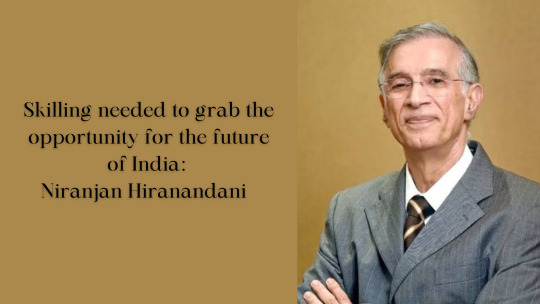
We're all hoping that 2022 will be a stellar year after the two years that we've had. It's perhaps been a mixed bag for most but what have been the biggest learnings from this year?
I would look at the learnings not in the last one year but the last couple of years. The challenges of the economy are big learnings. And how do we see these challenges? We have had challenges from Covid, where there were also people working from home (WFH). People couldn't reach the places of work or school or anything. We have challenges with interest rate hike. That continues to be a big challenge. It was a challenge in order to get the execution of the projects. There are multiple challenges.
The fact that we have overcome the obstacles has been the glory of this nation. The world's vaccines are made by us. Both the housing stock and the infrastructure have grown. Even with rising borrowing rates and costs, people still desire more homes. Overall, then, our nation is resilient.
Yes, both personally and as a whole the economy is facing challenges, but we are surmounting them with tremendous assistance from the federal government, state governments, and other authorities. Much has been learned about how to turn all of these obstacles into business opportunities.
Could you call out the big trends as you see it in 2023?
As per Niranjan Hiranandani, The recessionary tendencies that occurred in 2022 will end in 2023. Everyone was concerned about the state of the economy. 2023 will see a change in the economy and an upward trajectory.
The Russian-Ukrainian war will come to an end or at least be lessened within a year or two. It cannot go on indefinitely at its current pace. All of it will make things lot easier on the supply end and normalize lower petroleum prices. Overall, there will be a change in circumstances. India's economy will keep expanding. India's leadership tale will spread throughout the globe, and business will carry on in a very good way.
There are, in my opinion, difficulties with that. Specifically, we lack the necessary abilities to contribute to India's growth narrative. I believe that in order to take advantage of the current circumstances and seize the potential for India's future, considerably more skill development is necessary.
Know More :- Why have luxury homes accorded a notable uptick in sales velocity post covid?
What advice would you like to share with the viewers of leaders of tomorrow?
Entrepreneurs need to be patient, observe, and know how to come up with fresh, creative ideas. Fill up the economic holes. Determine the chances they can take advantage of and prepare for the economic recovery. Now is the ideal moment to think things through, make the necessary arrangements, and then wait for the opportune time to start the job.
Naturally, those industries that are not expanding at the same rate may need to adopt a more conservative posture, especially if they are export-oriented and there is a recessionary tendency in the nations to which they sell. Of course, that issue will persist. Overall, things appear to be going pretty well within the nation.
We will have to wait and watch what happens to the war, the economies of the West and other nations, and the places where economies are currently faltering, outside of the country.
What idea do you want to leave us with?
It is impossible to pinpoint a single attribute that will define tomorrow's leaders. If you consider it to be the most crucial, knowing the requirements of each and every stakeholder in your company is essential, says Niranjan Hiranandani news.
Therefore, in order to succeed, we must always be aware of the needs of each of these groups, whether they are your clients, employees, suppliers, partners, or bankers. This is because, if you need to advance in your leadership role, you cannot claim that you won't have the funds, that you won't have the best interests of all of your stakeholders, or that you won't take care of new investment opportunities.
0 notes
Text
Basement Arts Project, Bruce Davies and his role promoting young artists and broadening their audience and providing hope to a local community.
I don’t think I have ever attended anything that has brought into focus more just how selfish most of us our with our time and our space as the discussion we had with Bruce Davies. I was dumbfounded that an ‘ordinary’ person would sacrifice so much of their time, and ultimately personal space in the pursuit of helping both fledgling artists and the community as a whole.
Standing on the previously barren, syringe-strewn patch of land opposite the front steps of his terraced house I was minded about just how many similar patches of land there are around the country and how many of them would benefit from a raw and imposing piece of sculpture like the one he managed to achieve. How many local youths / adults could benefit from working on these plots as a community and the subsequent respect for the space that is then achieved. What could my role be in this? I listened in awe as he detailed the lengths he had gone to in order to secure this land and then obtain the piece of stone that the sculpture would be made from and wondered what on earth I do with my spare time.
The sculpture itself was big and imposing but it was the impact that putting this there, in the centre of Beeston, one of the most impoverished parts of Leeds, had on the surrounding community. To then discover that not only had he achieved this but that he also housed an art gallery in his basement only exacerbated my shame! Walking to the gallery, I had the opportunity to ask him what his motivation was for doing this and his response was straight-forward. Young artists have literally no opportunities to exhibit their work and he was unable to find any other space for them. His basement was free and so ‘why not use it’? It struck me that in an ideal world, wouldn’t it be fantastic to set up a network of Basement Arts Projects? Surely this can be a possibility. There must be people all over the country with an interest in art and the space to display it. I was utterly intrigued to see what sort of space this would be.
It felt like I was intruding as we all marched into his kitchen, turned right and descended the staircase to his basement. Questions were buzzing round my head – how does he manage this with a family, do the family get involved, how often are these events, is the space open all day every day?
Bruce openly discussed all of this with us – yes it is a family thing, they have evening viewings on specific days timetabled according to him. What was surprising and refreshing was how ‘rudimentary’ the space was. Nothing had been adjusted to allow for these exhibitions. Cabling was exposed, the walls were damp in some parts with paint was chipping off and remnants of previous shows remained present, the floor was uneven and the stairs lacked a hand rail. Health and safety were refreshingly absent adding to the narrative of the urgency of artists to just have ‘a space’. Here they can display their work as they wish. This requires a creativity in itself. It was fascinating to learn that there are mix of patrons to this project. Bruce said that it was roughly a 50/50 split of people connected with the art world and local people. This does demonstrate that people from all walks of life enjoy art and when access is given they will attend. The conversations that art promotes are any many ways vital and this is a fantastic addition to this local area. Not only this but in selecting artists whom he believes are of interest, they are able to display their work for free and make contacts with potential patrons or people who can further their careers. Bruce’s work is vital in this respect. Whilst it may seem he is only changing his small corner of Leeds, if we all did something to help our local area in a small way the knock on benefits would surely be considerable.
0 notes
Text
Sam loves Dean as much as Dean loves Sam: a meta

Much as I love reading good meta, I don’t often write meta. Thus please accept my apologies if this is mediocre, and let me start with a simple topic sentence:
Sam loves Dean as much as Dean loves Sam.
A little longer, now: Sam is even better at loving Dean than Dean is at loving Sam because of Dean’s profound and abiding love for Sam.
Confusing, right? But not really.
We all know how Dean lives and breathes SammySammySammywatchoutforSammy. It’s his defining mission, his ultimate purpose, or, as a therapist might say, his “core belief.” But sometimes I think that we allow adult!Dean too little autonomy. We assume that he can’t help himself: he’s locked into this single-minded focus, on loving and protecting the only family he has left.
That sells Dean short. (Hang in there, I promise I’ll get to Sam in a moment.)
Even people who have been forced into a certain way of life have choices. Even people who have been told who they are all their life have choices. Dean tells us, in Season 14, I’m good with who I am--and I, for one, believe him. Whether we follow canon all the way to 15x17, when Dean is finally brought back from the edge of his desire for revenge against Chuck by his love for Sam (the only thing that’s “real”), or whether we keep to season 1 when Dean said--that’s all we have...that’s all I have... and I want us to be a family again and as long as I’m around, nothing bad is gonna happen to you--Dean has always accepted his role as Sam’s big brother. Dean’s life is unabashedly Sam-centric. He’d change a lot of things, but in the end he’d change nothing, because he wouldn’t change that.
Some fans get very het up about the codependent aspect of this. Others (in my opinion, rightly) defend it. There’s scads of meta on why the Winchester dynamic IS necessary for their mythic role in the narrative, and their human role in the narrative (more importantly), so I won’t write that meta now. All I’m saying is what I think you already know: Dean lives for Sam, his baby brother, and despite the grief, the growing pains, the occasional cruelty of desperate love, Dean said it all when he told Sam (and us), Don’t you ever think that there is anything, past or present that I would put in front of you.
So where does that leave Sam, and his love for Dean? Let’s start with that line I just quoted. Building on the above, Dean’s goal in life is to give Sam a life. He wants Sam to be happy. He wants him to be free. He also wants to keep him by his side forever, to control him for safety and comfort’s sake, and sometimes those instincts of a frightened-child-turned-traumatized-man win out. Dean isn’t perfect. Dean’s full of contradictions. But time and again he goes back to stone number one: what he can do for Sam. What he can offer Sam, by being the grunt, by standing in harm’s way.
When we begin the story, Sam has succeeded in the path Dean helped carve for him. I’m not taking all the credit from Sam here, and giving it Dean: merely pointing out that Dean stepped into traditional parental roles and helped send Sam into adulthood, even though that meant Sam leaving him. We know that the night Sam left for Stanford was one of the worst of Dean’s life, but even in mid-season 1, Dean tells Sam he’s proud of him. You always know what you want. You stand up to Dad. Hell, sometimes I wish I--
(this, of course, is beautifully echoed in the series finale itself)
Dean is telling Sam what so many parents tell their children: you have gone places I never could, accomplished goals I never could, grown in grace and understanding like I never could. At least, I like to think that’s what the best parents tell their children.
To Dean, Sam is always the one with more hope. More wholeness. More options. To Sam, Dean is stone number one.
You asked how Sam loves Dean, and my answer is: just look. Look at how Sam goes out into the world young, stands up to their father, makes his own decisions, fights back against Dean’s own nihilistic narrative through their primary losses and setbacks. Dean gave Sam the safety to build a better worldview than Dean himself has, and Sam turns that right back around and tries to give it to Dean.
What do you think my job is? You’re my big brother--there’s nothing I wouldn’t do for you.
I can’t lose you.
You’re not a grunt, Dean, you’re a genius.
This is my life. I love it. But I can’t do it without my brother. I don’t want to do it without my brother.
I am going to save my brother. And then I’m going to kill you dead.
If you ever need to talk about anything with anybody, you got somebody right here next to you.
I believe in us.
This is just a small collection of Sam quotes showing his love for Dean. A small collection showing the persistent theme of Sam’s persistence. He knows that pushing chick-flick moments and emotional conversations can get jokes for a dime a dozen, and even the occasional punch thrown his way. He keeps at it anyway. When Sam knows Dean’s hurting, he wants to help. He’d do anything to help. He won’t sit around and see his brother turn into an embittered killer (season 2), go to hell for saving his life (season 3), take on the Trials (season 8), be irrevocably corrupted by the Mark of Cain (seasons 9-10), let him despair (seasons 11 and 13), let him sacrifice himself to an archangel’s grave (season 14), or let him lose his goodness to the whims of a vicious god (season 15). Sam fights for Dean with full use of his considerable gifts--intelligence, rationality, resourcefulness, and yes, the occasional blind rage. Sam looks to Dean, first as a leader, then as a judge, and finally as an equal. Sam has been looking up to Dean since he was four, yes, but over the course of the show he comes to look at Dean. With love, peace, understanding, humor, pain...whatever their inimitable connection requires.
The quotes I noted above also reveal Sam’s own conflicts rear up. Sam and Dean (again, in my opinion) are equally developed characters. Both have flaws and inconsistencies. Both have struggles inherent to their personalities and upbringings, distinct from those imposed on them by supernatural forces.
Sam had a glimpse of a different life, once. He had the smarts, he had the drive, he had the sheer stubbornness to live a different life than John or Azazel or hell, even Lucifer had planned for him. But also in Sam--innate in Sam--is his core of goodness and compassion and the principle of doing right, which leads him back into the life and to soul-crushing sacrifice again and again.
Sam breaks and is broken. Sam suffers and ages and spends more time in hell than even Dean, who went to protect him.
But what keeps Sam going? Dean. Dean can’t live without Sam. We know that. The flip side is that Sam doesn’t want to live without Dean. Importantly, I think, he has more choice in the matter. Dean focused his whole childhood identity on giving Sam a life that meant he had choices, even if Dean didn’t know he was doing that. Sam can move through more crowds, more roles, more relationships. He has a better education, he has a more powerful ability to intellectually reason and detach. He would have made a great lawyer. Yet he casts all this aside out of sheer willpower, choosing instead to love Dean and live with Dean through the chaos of their lives, and to go near mad when Dean is gone. Consider Sam in season 4, Sam in season 10...Sam in season 8 trying to atone for the very choice that Dean (the best part of Dean) wanted him to make, even if the real muddle of Dean’s psyche couldn’t forgive him, for a time, for making it.
All of this leads us to the finale.
You said you wish Sam had said I love you back to Dean in the finale. I argue that he did. He made his love perfectly clear to Dean in that moment by holding his hand, by looking in his eyes. He said, you can go now, when all he wanted was for Dean to stay.
The best part of Dean wanted Sam to have happiness and freedom. At the end of his life, Dean was finally able to communicate that without fear or reservation.
But the bittersweet brilliance of that moment is that Sam--the Stanford boy who went to hell and back, who saved the world, brought down one god and raised another--no longer wanted any kind of happiness or freedom that didn’t include the one person who’d been by his side all along. Dean was giving his blessing for a path that didn’t beckon Sam anymore. And yet: Sam said yes to it out of the love for Dean. Sam went out of that barn, out of the bunker, out of that day and that year and that decade and into the next and the next, out of love for Dean. Sam loved Dean by living. He loved Dean by raising another Winchester. He loved Dean by holding all their contradictions, flaws, and heroisms in his heart (in their car), until he’d done what he set out to do many times over.
Then he met Dean on a mended bridge, dressed in old clothes that said: I was happiest at the beginning. I was happiest when we could be brothers again. I took my time getting here anyway, because I know that was what you wanted. I took my time so that we could be happiest now.
If that isn’t love, I don’t know what is.
#my meta#meta#spn meta#the epic love story of sam and dean#sam winchester#dean winchester#spn positive#spn#supernatural#carry on#spn finale#sam loves dean as much as dean love sam#winchesters#sam n dean#sam and dean
577 notes
·
View notes
Text
Van Zieks - the Examination, part 12
Warnings: SPOILERS for The Great Ace Attorney: Chronicles. Additional warning for racist sentiments uttered by fictional characters (and screencaps to show these sentiments).
Disclaimer: (see Part 1 for the more detailed disclaimer.)
- These posts are not meant to be taken as fact. Everything I’m outlining stems from my own views and experiences. If you believe that I’ve missed or misinterpreted something, please let me know so I can edit the post accordingly.
-The purpose of these posts is an analysis, nothing more. Please do not come into these posts expecting me to either defend Barok van Zieks from haters, nor expecting me to encourage the hatred.
- I’m using the Western release of The Great Ace Attorney Chronicles for these posts, but may refer to the original Japanese dialogue of Dai Gyakuten Saiban if needed to compare what’s said. This also means I’m using the localized names and localized romanization of the names to stay consistent.
-It doesn’t matter one bit to me whether you like Barok van Zieks or dislike him. However, I will ask that everyone who comments refrains from attacking real, actual people.
Part 1
Part 2
Part 3
Part 4
Part 5
Part 6
Part 7
Part 8
Part 9
Part 10
Part 11
Let's bring this thing home! It's time for the conclusion of the essay series!
Conclusion
With a stupidly long essay series behind us, it's time to look at what we've learned! Let's go back to Part 1 and review what we needed from Van Zieks's character development for a fully rounded redemption arc, shall we?
1) Present an antagonistic (possibly immoral) force who personifies Ryunosuke’s biggest personal obstacle/weakness, in this case racial prejudice.
2) Humanizing traits begin to show.
OPTIONAL: A backstory to justify any immorality he has.
3) Over time, Barok has his realization and sees the error of his ways.
4) Barok atones for his immorality, not simply through apology but by taking decisive steps.
5) The cast around him acknowledges his efforts and forgives him.
And looking at the main game (plus additional dialogue), we have...
1) Antagonistic force:

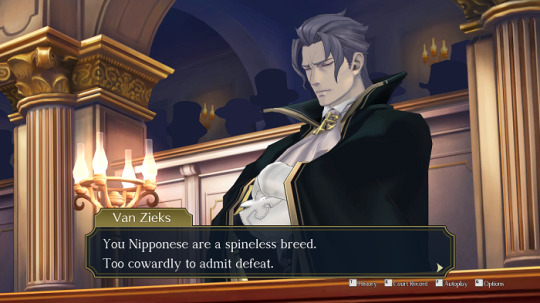
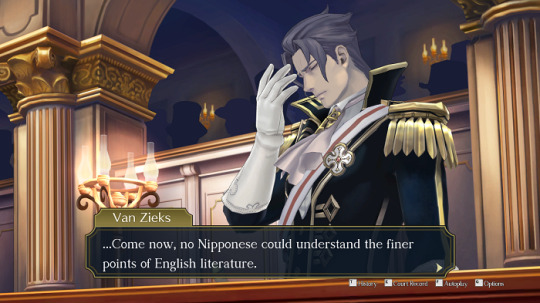
Etc. etc. I have many of these. We can all agree that as an antagonistic force, he does his job quite well. CEO of Racism and White Privilege in the flesh. It works, since we as the audience get very frustrated and want to see him defeated.
2) Humanization:
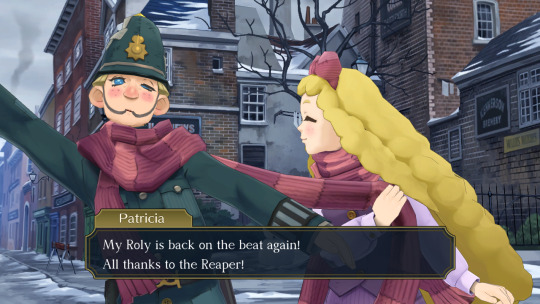
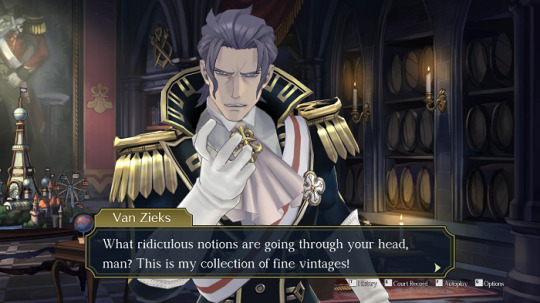

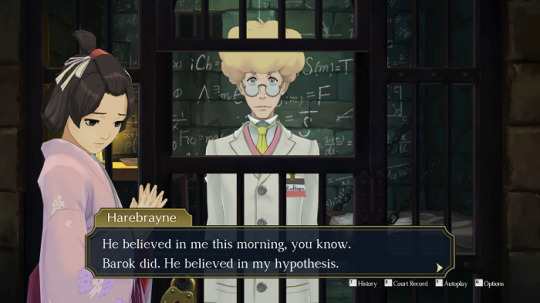
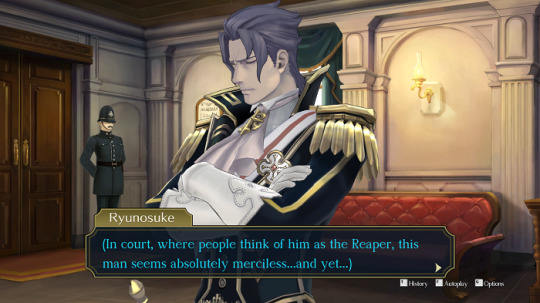

Giving him an old friend to be a defendant was a brilliant move, really. Albert's reflection on the friendship and the person Van Zieks used to be really helped flesh him out and make him appear more like a human being with, y'know, emotions and weaknesses. The little snippets of dialogue in his office really help too. Presenting evidence can also lead to fun tidbits. All in all, considering how gruff and distant Van Zieks is, they really did their very best to humanize him. The writers were given very little to work with but they exploited every opportunity to come their way.
OPTIONAL backstory:
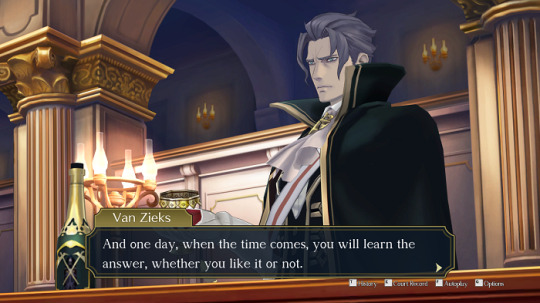
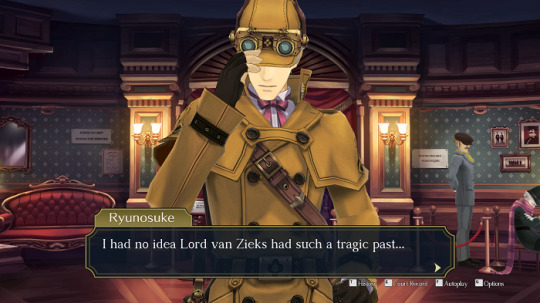
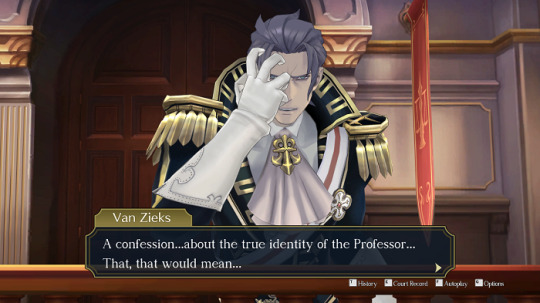
Again, I don't think we needed a tragic backstory to have a well-rounded, redeemable character. Still, it ties in very expertly to the game's plot and the motivations of quite a few other characters. The story of Klint van Zieks and his death isn't necessarily Barok van Zieks's backstory, it's the center of an intricate web which also holds Kazuma, Stronghart, Gregson, Jigoku, (S)Holmes, Mikotoba, Sithe, Drebber- I could go on. A LOT. So because of how very integrated it is into the main narrative's recurring themes and characters, I'll give it props for being relevant and well thought out.
The bigger question is: Does it justify his immorality? Not entirely. I think the game could have gotten more out of this if they'd involved the other two exchange students in this tale just a bit more. They could have given more attention to how Jigoku's aggressive behavior in the trial impacted Van Zieks, and explained whether he might've suspected Mikotoba of sabotaging (S)Holmes's investigation. If the narrative had done that, all three Japanese people to come to London would have been ‘the bad guy’ in Van Zieks's eyes and it would have given more credence to his racial generalization. They could have also given more attention to how the people around him reacted to Genshin being the Professor, because I'm sure Stronghart and Gregson stoked the fire in terms of xenophobia. As it stands, there isn't really enough there to justify hatred of an entire race as opposed to just one person.
3) Realization/Redemption
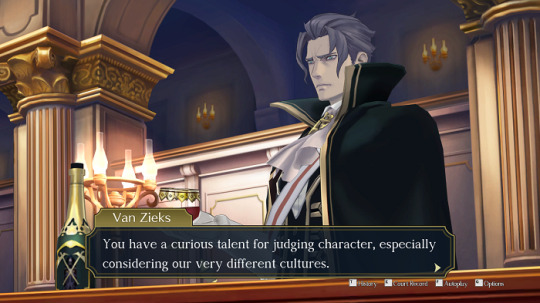
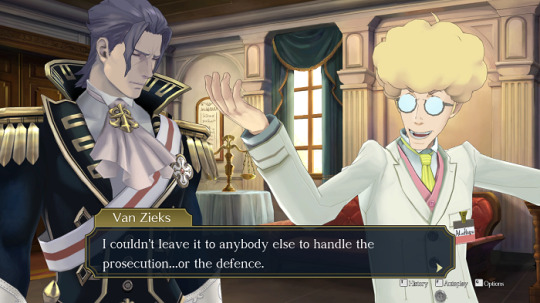
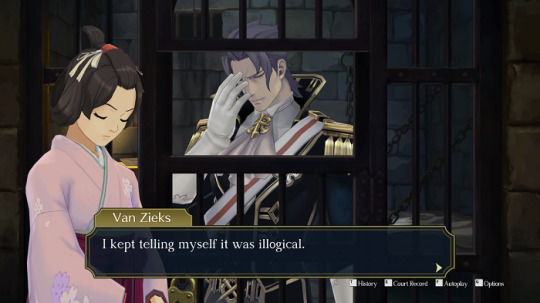
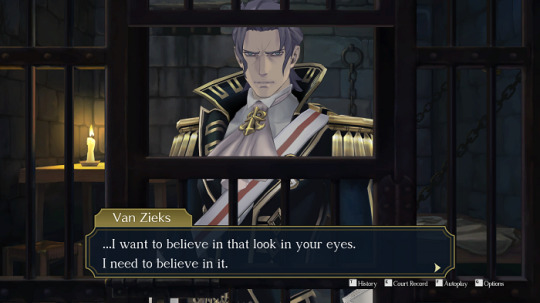
We see him already start to realize the error of his ways around the end of 1-5, which is technically only about halfway into the full narrative. Unfortunately, thanks to 2-2 being played afterwards (but chronologically set before 1-5), any progress made in 1-5 can become invalidated in the player's eyes. Growth works best when it's done linear. Don't get me wrong, flashbacking to earlier times when a character is still more morally tainted can work well, but it needs to be executed properly. Barok's behavior in 2-2 is downright insulting towards the audience itself and therefore, it causes emotional friction when relaying the narrative endgoal of redemption. It also makes it extra jarring when we hit 2-3, and suddenly Van Zieks is meant to be relying on the protagonist's desire to expose the truth. How on earth can we as the audience trust that Van Zieks believes in Ryu's abilities when we just came fresh out of a case where this man actively sabotages Ryu's efforts?
Still, the line of redemption continues from 2-3 into 2-4 well enough. He admits that he was wrong- that his hatred was illogical and that he needs to change. This is the very definition of redemption. I need to stress once more this is not to be confused with atonement, which comes next.
4) Atonement
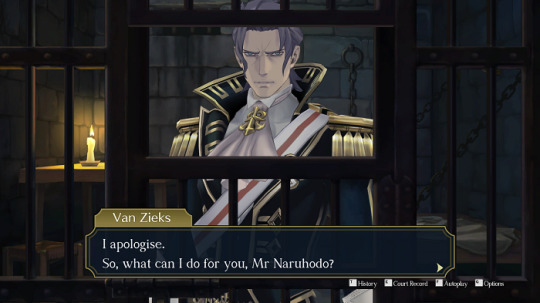
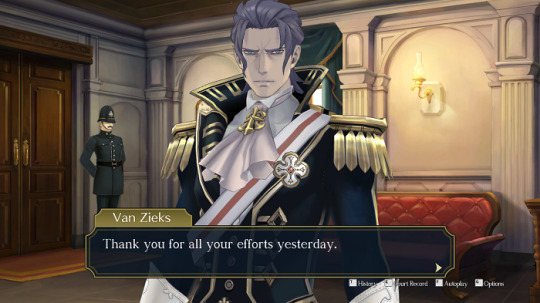

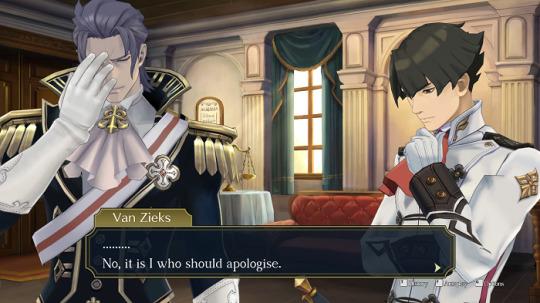
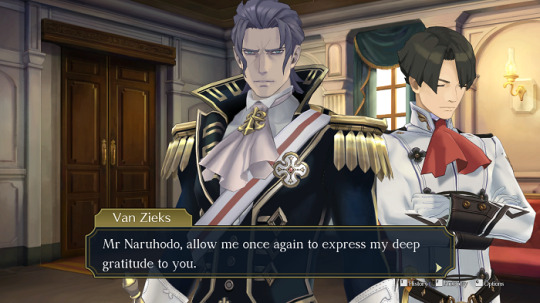
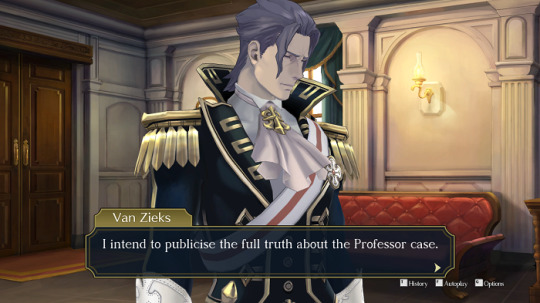
Here it is. It's not enough to simply acknowledge mistakes; one needs to work hard to fix them. Since Van Zieks is the defendant for two whole episodes, equaling roughly 20% of the full narrative and 67% of the time following his first true realization (chronologically), there isn't much that he can actively do to atone. Because remember, not only do these actions need to fit the situation he's currently in, they need to fit his personality. These two limitations ensure the atonement mostly takes the form of dialogue. Of apologies.
One might want to point out that he never apologizes specifically for his racism, but there's a reason for that. If you pay close attention, you'll notice that there isn't a single character who ever uses a word like “racism”, “xenophobia” or even “racial prejudice” in this game. It's for the same reason you'll never see an Ace Attorney character utter words like “alcoholism”, “drug abuse” or “depression”. These things may be implied very strongly, to the point where you'll know for certain a character is suffering from it, but it's never given these exact labels. It has to do with the tone of the game. In Great Ace Attorney's dialogue, Barok van Zieks is only ever described as holding “a deep hatred for Japanese”, which is then the only thing he could apologize for. And he does, so long as you aren't looking for a literal phrasing of “I apologize for my deep hatred of your people”.
Regardless, he can't take more active, decisive action until he's freed from prison and two scenes with Van Zieks later, the game has ended. He still manages to take two actions, though! The first is to publicize the truth of the Professor, taking the blame of the mass murders off Genshin's shoulders (and losing his own privilege in the process). The second is to take Kazuma under his wing as his disciple. I'm not certain there's anything else the narrative could have had him do. What is decisively missing, however, is the following:
5) Acknowledgment

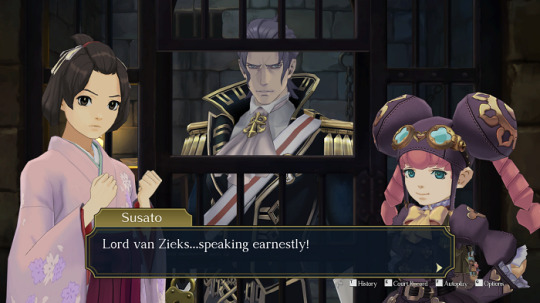

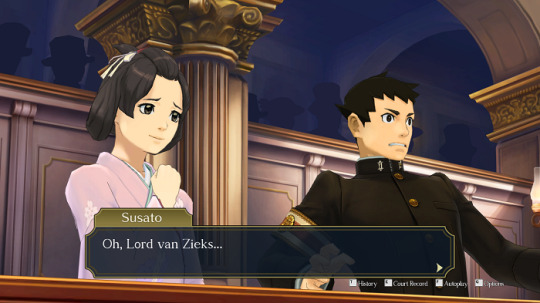
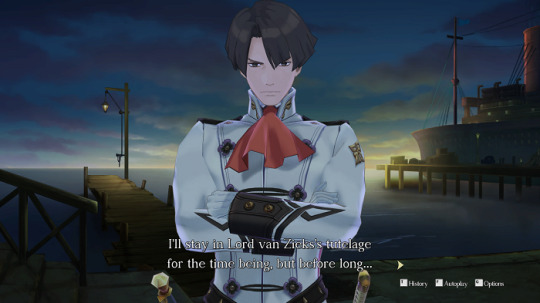
The above aren't good examples of cast acknowledgment that Van Zieks is taking part in a redemption arc, rather, they're the best I could find. Characters are acknowledging that he's changing- that he's being kinder to them and they can get along with him now, but they're not acknowledging that he caused hurt in the first place. This, in my opinion, is the Great Ace Attorney's biggest narrative flaw. I've talked before about how Ryu's reaction to Van Zieks's racism is 'indirect communication', a typically Japanese manner of dealing with negativity. I've also talked about how Ryu is not in a position to speak up, as he's a literal minority who is there to represent his country in an official capacity and can’t afford to make enemies. However, characters like Susato and Kazuma are far more outspoken in their opinions, as is Soseki. The only one who ever calls Van Zieks out on his racism is the British judge, and even that is done very meekly. When an old crusty white guy is the one who condemns white privilege in a cast full of minorities, you've got a problem. The Japanese cast's refusal to acknowledge that Van Zieks's words were harmful is like Team Avatar telling Zuko that sure, he can join since he's a good guy now, but never once acknowledging that he burned down villages or betrayed everyone's trust in Ba Sing Se. There's something very vital missing, see? If indeed the cast had called Van Zieks out more actively on his harmful ways and how necessary it was for him to change, he in turn could have taken more atonement steps in response.
So, for the conclusion: Does Barok van Zieks tick all the necessary boxes for a complete redemption arc? Yes. In a very technical sense, all the requirements are there. But does that mean it's a successful arc? Not necessarily. The game has a few slip-ups, a few things not executed as well as they could have been. For that reason, whether the audience is satisfied with the arc is entirely up to them. Taking into consideration that they had to cram a whole lot of story into just two games- the second game in particular, I can acknowledge they did their very best with the limitations that were there.
And there we have it! That’s all I could think to say on the matter. I hope everyone who read this till the very end enjoyed it, maybe even learned a thing or two. I’m always open to questions, input and constructive criticism!
#dgs#dgs spoilers#tgaa#tgaa spoilers#barok van zieks#I'M FREE!#well until I tackle the DLC content#but until then...#FREEEE
35 notes
·
View notes
Text
Warning: Rant, character bashing, lots of opinions
I'm saying it outright. I hate Deku. He is entirely underwhelming as a character, much less as the main character, the shonen protagonist of the series.
It's a 'different' type of dislike, though. I feel like I could've like his character. There's nothing greatly disagreeable about him, he's as inoffensive as can be, he's an optimistic, considerate, and polite boy, he's as plain as he is said to be, and that's fine.
My issue is that he's not the character he's said to be. I, personally, just don't buy that he "possesses a drive to save others that eclipses all common understanding", or that he's super intelligent with great analytical abilities that he actually applies on the battlefield, or, in general, he's as amazing or heroic or compassionate as he's apparently supposed to be. How can he be inspiring if he barely challenges any aspects of the society he lives in. Deku is a super good example of the terrible use of "Tell, Don't Show". We're told about his amazing traits, but he rarely follows through; when we do see hints of it, it's lauded but frankly I think it's typical behavior and (this though is not quite his fault) written so stiffly and awkwardly I'm not convinced.
(Honestly I might even call him a Canon Mary Sue. He has no interesting or distinguishable flaws, unless having a shit for brains attitude is one but that's not acknowledged by the narrative. Breaking bones is not a personality trait. If he has a Hero Complex, it's not even the interesting ones where he fucks things up even more; or carries crippling guilt about circumstances beyond his control; or focuses completely on saving people to the point of rejecting almost all human connections and keeping deadly secrets - which is All Might's big flaw.) (Well fair, he does this in the most recent chapter but did it need to take 300+ chapters? Plus I sense the way it's framed is that it's the radical, but right course of action.)
Say what you want about Villains and redemption/shouldn't be redeemed/too evil to be saved/justice/etc, but I think this 'Incredible Drive To Save' should've included Villains from the start. Why does Deku want to "Save people with a smile on his face"? Assuming it's empathy, he should have felt some towards everyone he encounters, whether it's sensible or not. "Why are you so angry?", "You shouldn't go about things this way", "What caused them to be like this?", "Why is there evil in the world?" even. I'm still fuming over his Mall Encounter with Shigaraki, where Shigaraki pretty much reveals his damage: "All Might acts like there's no one he can't save"; but ultimately Deku goes "Wow, that sure is an opinion."
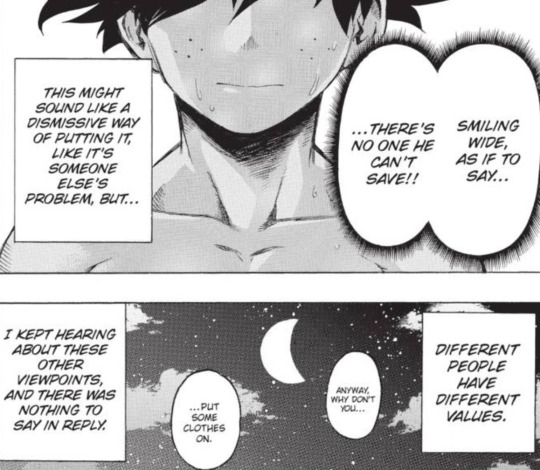
What kind of inane response is this??? There's little pushback from the narrative either, so this isn't pointed out as a failing of his (because, again, he has no big flaws). And he's supposed to be smart and caring. Yes, he does ask All Might right after the Mall Encounter, "Was there anyone you can't save?"; but essentially the replies he gets is "Don't worry about it" and Deku immediately largely puts it out of his mind "Oh whew, I was about to do some introspection and reflection". There isn't even the daunting, kinda-existential anxiety that people get when they realize it's impossible to save/help everyone - which is something, like, medical workers have to learn to deal with - that sharp sense of the inevitably of death, of loss, failure, guilt. I'm not asking for him to come to the conclusion that everyone should be saved - he could've decided nah, Shigaraki is too ugly to be saved and I would've been fine with that, it's part of the character role and potential development - just that he should've had a conclusion at all.
There are the latest chapters where Deku decides he wants to try saving Shigaraki first (though killing him is still on the table), true. Him wanting to save Shigaraki after seeing AFO merged with him, after seeing The Crying Child - but see, I don't think it qualifies because I think it's the bare minimum about of consideration, the typical response to seeing the body horror of warped, fused flesh, to seeing a small sad little boy. I think it shouldn't require "You look like you needed saving" for a true Hero to consider saving someone. Not for someone who is supposed to be unique and special in this regard.
*
I've complained about this before, but the trouble with Deku was evident from the very beginning.
Again, Deku wants to save people with a smile on his face, and again, I’m assuming it’s empathy. We're shown this on the very first page, as he attempts to protect a friend(?) from bullies, but imo like it felt groundless because who was the kid he was protecting? We never see him again. Did Deku's standing up to Bakugou work, and the kid was saved? Or did they both got beaten up; but afterwards, being the kind boy Deku is supposed to be, he still gets to his feet to help the boy, to apologize for failing.
But more significantly, this theme of saving was overshadowed immediately by his focus on superpowers - that he was quirkless. Next page, his focus was on ‘Woah, giant villain and superpowers!’ Instead of like. Helping people. (Though I chalk this up to early installment weirdness)
What should’ve happened if the theme was ‘SAVE PEOPLE’ Is something like: The opening sentence being “People are not born equal. This is the harsh truth I learned when I was four. I knew that... but despite my powerless, I still wanted to help. That was my first and last setback.” And the panels/images themselves (of little Katsuki and his friends) implies that people on the world thinks you need power to help people.
When he saw the villain attack on way to school, Deku can be wow’ed by the spectacle! But then he notices a kid crying and offers to help find his mom. He can be interrupted by a Hero saying he (the hero) will take over, he can find the mom and realize he’s late for school (and so that shows he’s willing to sacrifice something of his to help others! Because of his altruistic nature!). A scene like that, of him helping the lost kid, we would know that he wants to help *anyone*. At school, though, he still gets bullied for not having powers. So he’s mulling over that when he meets All Might, and asks the question.
It proceeds as usual for the next few events: When the sludge monster attacks Katsuki, he can still go gawk at the scene. He can still hesitate. In canon, it's only when he realized the victim was his friend that he jumps into action, which I thinks undermines the theme of 'wanting to save indiscriminately'. IMO, it would've been better that Deku sees it’s his friend, but he still hesitates. “There’s nothing I can do right? All Might himself said so...” But when he sees Katsuki’s *face* of fear, he runs to help. Instead of seeming like he helps only because he realizes it’s his friend, he helps because he feels too deeply about trying to save Katsuki.
Admittedly these are minor, personal critiques; but all in all, the first chapter fails to establish Deku is the willpowered, champion of wanting to save people he's supposed to be.
--Which is fine, if it's acknowledged in the story later, that maybe he wasn't the True Blue Hero he's supposed to be at first, but he can change and still become one. But it's not - Deku is apparently special, without anything special to show for it.
*
I read the one-shot "My Hero" - the prototype for this series - that Horikoshi published years ago, before My Hero Academia was created. I also found it underwhelming, but that was due to personal tastes (I wanted more explosions and dumb violence); as a story on it's own merit, the logic and progression was solid.
The Villains Heroes fought were 'Aberrations' - true inhuman monsters that showed no sentience that would eat people - so the focus could be solely on saving humans. The main character - Jack Midoriya - his original goal was less 'save people' and more 'become a cool hero', before learning that saving people is what true heroism is about, hero license unneeded. (Moreover, he really did 'save' someone without being a hero - by working hard, he was preventing the company from becoming ruined completely, which the CEO had confessed and thanked him for. )
This version of Midoriya didn't exactly needed deep empathy or compassion for that, just a strong willpower, which he effectively demonstrated by chasing after a childhood dream even as an adult salaryman in a tanking company, even though he had anemia and no training and no license. He insisted on this, to the point of getting hurt by being dumb, of being petty over someone dissing the Hero who inspired him in the first place, of skipping out of work and going vigilante. Not the most upstanding guy, but he came through in the relevant themes of the story, in being the character the story needed him to be.

Jack Midoriya was an unimpressive, weird-looking, weak, pitiful, somewhat selfish, awkward salaryman with no great aspects that 'eclipses all common understanding'. But he was a far stronger character than his incarnation Izuku Midoriya could ever be (so far).
114 notes
·
View notes
Note
What do you think could have been done to improve 3H? Given the budget/time, what changes would you have done? Also, what elements do you consider KEY to a good story?
fffffff I would have done so many things differently in 3H it requires a read more but to your second question: I feel that characters are a key element of a good story. Possibly the most crucial element, to me. You can have the most epic, incredible plot in the world -- but if the characters taking part in it aren't interesting or able to engage the reader, then the story loses a huge part of its impact. It's only by caring about the people taking part that a reader can get invested in the story and its outcome; if you don't care about what happens to someone (either in a good or a bad way) then you're at best apathetic to the events, at worst bored by them.
Frankly everything else in a story -- narrative structure, conflict, etc -- is so malleable that I can't consider it key. You can easily make stories that have no classic conflict if you have characters that people care about, because just watching them interact with the world and each other can be beautifully engaging. So at least to me, the key is in the characters: whether you love them and want them to succeed or love to hate them and want to see them get their just desserts, they're the ones that do the heavy lifting in a story, so making sure they're compelling is one of the most important things to me when writing.
As for 3H though I have a lot of changes I would make. Throughout the whole game.
Academy Phase
Giving each House their own unique set of missions. I feel that part of why the Azure Moon route is considered so strong is because it's the most character driven, something that starts in the Academy Phase: everything from Lonato's rebellion to Miklan's theft of the Gautier Relic are highly personal to the Blue Lions students, with Ashe being Lonato's adoptive son and Miklan being Sylvain's estranged older brother (and someone who's well-known to Dimitri, Felix, and Ingrid on top of it). While these are both important events, for the Black Eagles and the Golden Deer there's not the same level of personal engagement: it's just a thing that's happening rather than a devastating blow to the students we love. While there are certainly missions that can and should stay the same (the raid on Seiros' tomb, Flayn's kidnapping, the Remire incident, etc.) having select missions be personalized by House to give that same level of engagement would have made for a far stronger narrative, since it enhances the player's connection with the students of their chosen House.
Just as an example: for the Black Eagles, rather than putting down Lonato's rebellion, maybe have their mission be aiding a small sect of the Church in the Empire that's being plagued by monsters or bandits. It gives us the chance to learn more of the history between the Church of Seiros and the Adrestian Empire, how close they were and how it fell apart a century before the game; Rhea might explain that she wants to improve these failing relations by having Imperial students go to aid this disconnected branch, and in private Edelgard could hint at her distrust of the institution and of Rhea herself even if she is following orders. Not only that, we could hear on returning that the Blue Lions students accompanied the Knights of Seiros in dealing with Lonato's rebellion, so we still get the fallout from those events and have a reason to choose the Blue Lions in another run.
Another example: for the Golden Deer, rather than going after Miklan and witnessing his transformation, maybe a report arrives that someone stole Failnaught and task the Alliance students with retrieving it. It lets us learn more about the situation in the Alliance, giving more details about Duke Oswald's situation, Claude's appointment as the heir to the Riegan House...and while he would never do it personally, have there be subtle implications but no hard proof that Duke Gloucester is behind the theft, just as he was the death of Claude's Uncle; on top of that, we could still get a battle against a Black Beast when Failnaught transforms the bandit, giving Claude a very personal look at how dangerous these Relics can be (something he likely wouldn't have had deep insight into, given his Almyran roots). And again, on returning to the monastery we could see the Blue Lions dealing with the fallout from Miklan.
More interaction between the House Leaders in general. There are only a handful of scenes where all three of them interact together, and I can only think of one instance where they're even in each other's company at the monastery (Claude and Dimitri in one of the early chapters). Having more of these moments where they're apparently interacting on the grounds or where we can see them together in cutscenes, giving us more insight into the leaders of the other Houses we didn't pick, would give us a lot more investment in them as people and make the eventual revelations at the end of the Academy Phase hit a lot harder.
Especially with Claude's ambition being what it is, it would have been a far better show of his character to have him hanging out with different students every month -- not just from his own House like Hilda, but from other Houses. Have him be talking with Petra in the dining hall one month, or with Annette at the reception hall another; if you sided with the Black Eagles or the Blue Lions, it would be very easy to suspect that he's up to tricks and trying to figure out individual weaknesses...but if you picked the Golden Deer, you'd likely realize very quickly that he's got no ulterior motives because you've been seeing him in action and getting Supports with him.
More Supports period. We were robbed of some fascinating interactions, like Ashe and Dorothea or Dedue and Petra, and some really strong Support chains stop before they reach their full potential (several Sylvain supports, including Marianne and Bernadetta). I want to see so many more of these and I would add in a ton if given half an opportunity.
Giving Byleth more agency. This bleeds over into the War Phase, too, but one of my biggest complaints about the game is how limited the response options are, especially when it comes to Edelgard and her frightening rhetoric as early as chapter 3. Give us more options with real varied outcomes, rather than it changing one immediate line of dialogue; give us real dialogue trees rather than minutely altered responses so that we have an opportunity to affect change. This runs the risk of drastically altering Byleth's relationship with the various House Leaders, but that potential is undeniably fascinating in and of itself.
War Phase
Azure Moon: Make Dimitri's turn more gradual. Show him grappling with Rodrigue's words more, have more scenes where he and Byleth talk and he tries to work through his understandably complicated feelings. It doesn't even have to take that much longer, honestly: every week for the next month, give us an extra cutscene and let there be a small change in how you can interact with him. For example, maybe he still doesn't attend the round table in the first week, but you do have the option of assigning him to a task around the monastery; in the second week if you explore, you have the option to invite him to a meal; in the third week he finally attends the roundtable and you're able to work on his skills again; and in the fourth week his supports finally unlock.
Azure Moon: Make Claude recruitable. Don't have him leave Failnaught and go waltzing back to Almyra, have him actually head up the Alliance in this time of need and volunteer to join forces with the Kingdom forces. You can have the option of turning him down, if you really want, at which point he might leave Lorenz in charge and go back home, but give us the option of bringing him on board along with any other former Deer that fought with him at Derdriu -- and furthermore, let us have some supports with Dedue and Dimitri to go with it. Ideally those Support chains would be available in the Academy phase and maybe you'd have the recruitment option only if Dimitr's Support level with Claude is at least a B (since you can get to A during the Academy Phase but not unlock it until the War Phase as I experienced many times). But still: Claude recruitment. Yes.
Verdant Wind: Make Dimitri recruitable. Having him die offscreen after Gronder is absolutely terrible, especially since we know for a fact that at least two people from the Alliance army saw what was either going to happen or directly happening. At the end of the battle, give us an option of going after Dimitri: if you choose not to, he still dies, but if you do you have the opportunity to save him and recruit any other former Lions with him. As abve, Supports between Claude and Dimitri would be great, and you could even keep Dimitri's Supports locked for a while and include scenes of Byleth and/or Claude and Dimitri talking and working with him until he starts turning around the way he does in Azure Moon. Dimitri's death in Verdant Wind is a travesty and it needs to be changed.
Verdant Wind: More character stuff in general. One of the things that makes Azure Moon such a strong route is that it's so deeply character-driven. Verdant Wind is much more plot-driven, and while it's still strong, it could have been more impactful if the characters were more directly affected and/or we got to see more of their individual actions. For instance: after securing Myrddin, have weekly missions where you actually go along and meet with the Great Lords and discuss with them before the final round table. Have Byleth and Claude go with Lorenz to talk to Count Gloucester and try to get his buy-in, and give us more dialogue trees where Byleth can contribute (for better or for worse) so that in the end you either get his full agreement or only grudging consideration because Lorenz intervenes. Get us engaged, show us more of the situation in the Alliance, and let us have a role in moving from this uneasy state of neutrality to full agreement that it's time to take action.
Silver Snow: A unique story in general. Basically everything in the route is a weaker copy of the events in Verdant Wind, and regardless of which came first, Verdant Wind handles the events in a way that makes more logical and narrative sense than Silver Snow does. So even if things could be changed in Verdant Wind to make it stronger and more unique, Silver Snow needs the most work and ideally should have a new plot made just for them that gives the Knights of Seiros a chance to really shine.
Silver Snow: More for Seteth to do period. Despite the fact that he's ostensibly our Lord stand-in for the route (since he's the one who meets you after the timeskip, where it's either Claude, Dimitri, or Edelgard who does in the other routes), he barely has a chance to do anything and doesn't make much of an impact on the route overall. Silver Snow could -- and ostensibly should -- give him a chance to showcase his talents and stand as a unique and engaging character, since his role in the Academy Phase was so minor; relegating him to the same general role in Silver Snow does him a great injustice.
Crimson Flower: Have Edelgard suffer consequences. This is one of my biggest complaints with the game on the whole: that Crimson Flower goes out of is way to glorify imperialism and Edelgard gets a rosy perfect ending with nothing ever going wrong according to her endcards. Logically the way she achieved her goal would have led to massive dissent, unrest, and civil conflict in the territories she conquered and subjugated; her route needs to show that, and make it clear that there are in fact consequences for her actions, both within the original Adrestian territry and without in the newly conquered ones.
Crimson Flower: Deal with the damn Agarthans. Given that she knows about them in detail the way neither of her fellow House Lords did, it's an absolute travesty that we never saw her go after them in her route: all she did was show her hand too early and cause hundreds of senseless deaths when the Agarthans fired on Arianrhod. Her route should have ended with a conflict against the Agarthan menace -- and likely a very hard one, harder even than the battle against Rhea, because she left them for too long and gave them time to bolster their defenses before she arrived. And given that she's killed Rhea, the end of that conflict would likely be a massive loss of life when Thales bombs Shambhala -- further consequences for her actions.
All Routes: Give Byleth agency. This is especially pertinent in CF where canon reduced Byleth to Edelgard's enabler: give them a chance to fight her, push back against things that either don't make sense or are only going to hurt people, argue and maybe force her to change her mind or see another viewpoint rather than continuing to barrel down a path of bloodshed and loss because she selfishly decided that war was the only way. But giving Byleth that same agency in other routes would be equally powerful: let them talk candidly with Dimitri, let them encourage Claude to trust his companions and reveal his Almyran heritage, just...let them have a chance to be their own person, with complicated relationships and the ability to speak freely.
#answered#21stcenturyhero#fire emblem: three houses#look i enjoy 3h a lot#but it's also kind of a mess when you think about it#these are just the immediate changes that come to mind#there are probably more improvements that could be made#but these are a good start#and would have made a much stronger game#at least in my opinion
32 notes
·
View notes
Text
"The promised land, I think I can meet her there".
This article argues that it's unreasonable to see the line as a romantic gesture from Cloud, and that an alternative interpretation of the line as a comment concerning the impending doom is more likely.
__________________________________________________
People try to use this to prove that Cloud wants Aerith ever since 1997. Now lets be clear here, this interpretation is patently absurd as soon as you think about it for more than 2 seconds. Do you really think for a second that Square would end the game with Cloud randomly telling Tifa as they're about to die, "you know what I want to tell you before we die? I don't love you and I'm glad I'm dying so I can be with another woman in the afterlife"?
They wouldn't, this is the most unreasonable story interpretation I've ever heard, whatever that line is meant to mean, it wouldn't be that. Let's be clear here, the only people who think that this line is a genuine argument in favor of Clerith, are people who are already Cleriths.
They see the line, and find it to be in line with their beliefs, and it is. The problem is that that's not how science is done. The question isn't whether or not a piece of evidence is in line with your point of view, it's whether it disproves the opposite point of view, which in this case it doesn't. (Also see: "The Wittgenstein test")
It should be noted that arguments like these do not do Cleriths any favors, because in addition to proving nothing, they show something fundamentally problematic about the Clerith view of the story. In order to believe that this line in incompatible with a Cloti interpretation of the story, there are a number of tangentially related positions that you'd have to defend.
1: It's impossible to want to be reunited with anyone except if you love them romantically.
2: Cloud is an absolute asshole who would dump a woman he just had sex with, just as they're about to die.
3: Tifa is the worlds biggest simp.
4: This is how SE wants you to see their characters.
In one fell swoop of a bad story interpretation you've undermined the importance of all other forms of love, you've undermined the importance of Clouds character arc concerning guilt. You've basically trampled on those who suffer from mental health issues by simplifying their issues into love cliches, you've made a villain of Clouds character, made a mockery of Tifas character, and revealed that you don't understand basic storytelling.
This is the fundamental problem with these arguments that cause many of us to develop a distinct distaste for Clerith as a ship, because when Cleriths attempt to argue in favor of it, it often comes in the form insults towards all characters and stories involved. You could have a story about Cloud loving Aerith, but if defending said story requires you to argue that Cloud would leave a girl with two children, one of which is dying, for no other reason besides being lovesick, then that does a disservice to the characters, the story, and the franchise in general. In a sense, by trying to defend Clerith like this you're insulting the entirety of Final Fantasy.
Are there people who are assholes? Yes, are there people who get straight up "pumped and dumped"? Yes. Is that the sort of hero that SE is trying to show us? Obviously not.
(for more information regarding this I advise you read: Insane hobbits article where he touches on the differences between clean and messy narratives)
If SE wanted to end the game with Cloud proclaiming his love to Aerith in some way, they wouldn't have Tifa hanging on his side while he's doing it, and she wouldn't respond with "yeah, lets go meet her" like the universe biggest simp. So what is actually said? Well, I am not a translator, but as far as I can tell Japanese doesn't have pronouns and the line generally refers to meeting people in the promised land, which includes Tifa in the people going, and it's not specifically about Aerith. Is Aerith included? Of course, she's probably even the main person to meet there, she's certainly singled out as the person talked about by certain supplementary materials, but it's not a romantic sentiment, it's a tragic "we're about to die" sentiment, meant to convey a more generally positive message about being "reunited" with those who have died.
The more likely paraphrasing for this scene is:
"Cloud asks for an answer from the planet, the planet reveals the lifestream, Cloud and Tifa realize they're about to die.
Cloud muses that he thinks he gets it now, they're all going to die and be reunited in the lifestream, both with each other, as well as those who have died, with Aerith being the most obvious and recent example."
So is there any evidence for this? Well, for one there is the storyboard for the scene:
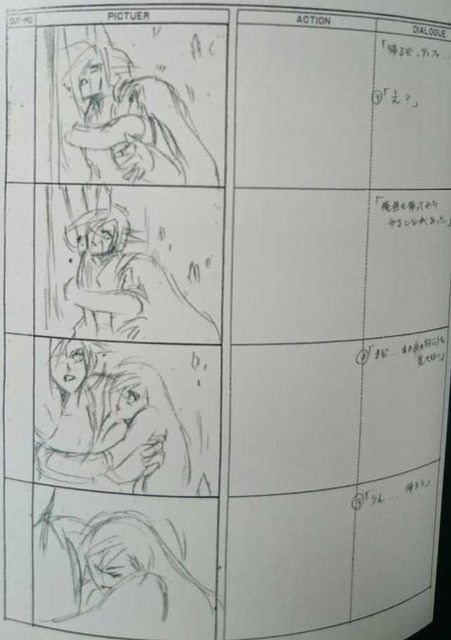
c「帰るぞティファ」
t「え?」
c「俺達も帰ってからやることがあった。まだ…あの山の向こうを見てない」
t「うん…帰ろう」
Cloud: "I'm going home Tifa"
Tifa: "What?"
Cloud "We had something to do after we got home. We haven't seen the other side of the mountain yet ..."
Tifa: "Yeah ... let's go home"
"the other side of the mountain" is a reference to the mountains of Nibleheim, where Tifa believed the dead went. In other words, this is either a reference to them going home because they have stuff to do, which ties into the general idea that Cloud and Co had to live in order for their sins to be forgiven, as is evidenced by:
“I’m going to live. I think that’s the only way I can be forgiven. All sorts of things… happened.” ~Cloud in case of Tifa.
Or more likely it's be a reference to how they're about to die. Neither interpretation says anything about this scene being intended to be a romantic sign towards Aerith. Now, of course, the line was changed, and intentions can change during development. But if we're unsure on what the meaning of a line is, then going back to the storyboard is a pretty good way to get context.
Page 27 of the FFVII Ultimania omega:

"They're talking about", confirming that this is a mutual discussion, and not Cloud in isolation.
Page 203 of the FFVII Ultimania omega:

Provides context for the intended ideas the line is meant to convey. It calls back to earlier concepts concerning death not being the end, and is something Cloud and Tifa talk about together.
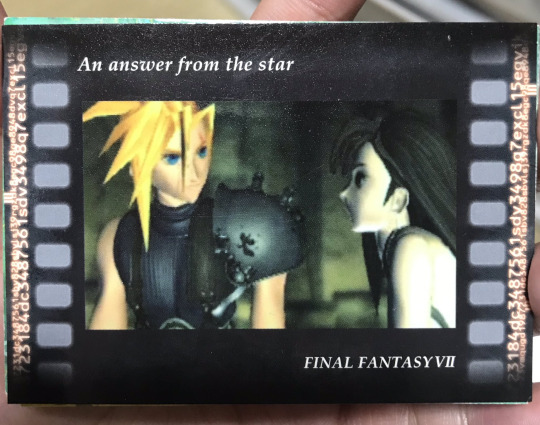
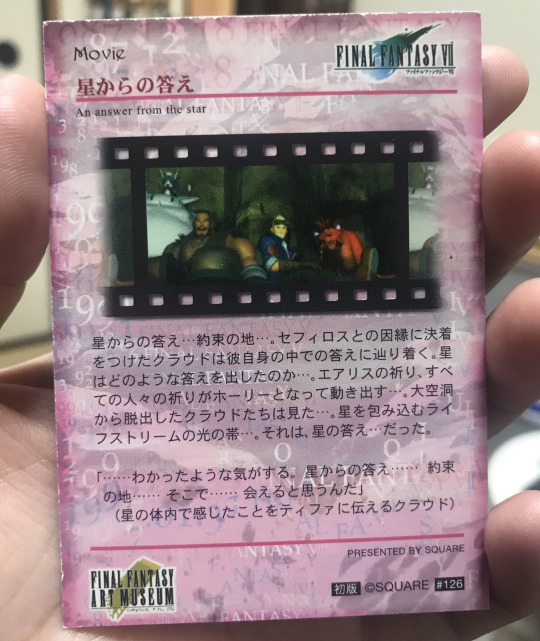
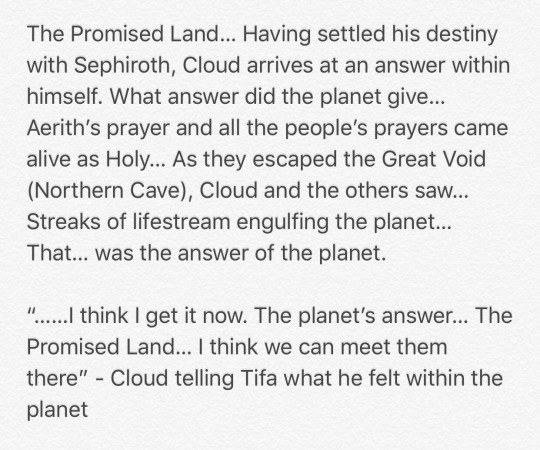
From: Final Fantasy Art Museum movie card
( https://twitter.com/dorobbongie )
These are not prescriptive canon, but descriptively they can give us some indication of how we're supposed to interpret the line.
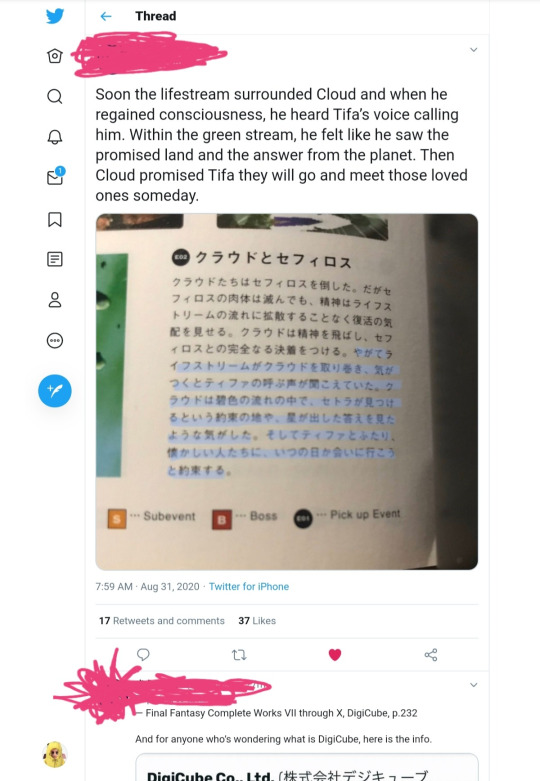
Also reinforces the idea that the final line is meant as a more inclusive statement concerning reunions after death.
Taking these points into consideration it becomes unreasonable to take the "I think I can meet her there" as a shipping line between Cloud and Aerith.
If it were:
SE wouldn't have hung Tifa from Clouds hips.
Wouldn't have had Tifa agree with the idea.
Wouldn't have done it as the two were about to die.
Wouldn't have the storyboard refer to a shared journey beyond the mountains.
And most importantly, SE wouldn't have followed it up with Cloud commenting moments later that he's going to live in order to atone for his sins, and that things would be different now that he has Tifa. Clearly meeting again in the afterlife was more of an immediate danger rather than an immediate goal:
As Tifa looked away from the sky towards the ground, she was fearful of the future. However, Cloud beside her chose to smile gently. It was a smile that she hadn’t seen before during their journey. Cloud noticed her gaze and asked, “What’s wrong?”
“Cloud, you’re smiling.”
“I am?”
“Yeah.”
“It all starts now. A new…”
Cloud looked for the right words.
“A new life.”
“I’m going to live. I think that’s the only way I can be forgiven. All sorts of things… happened.”
“That’s right…”
“But when I think about how many times I’ve thought about how I was going to start a new life, it’s funny.”
“Why?”
“Because I’ve always failed everything.”
“That’s not funny.”
“After this … I think I’ll be okay.”
Cloud was silent for a long time before he spoke again.
“Because I have you this time.”
“You’ve always had me.”
“What I mean is kind of different,” Cloud answered with another smile.
-Case of Tifa; revised; released with ACC.
__________________________________________
thank you "thelifestream.net" for some of this information, as well as Kagesakura (https://otp-oasis-heavenxearth.tumblr.com).
17 notes
·
View notes
Photo

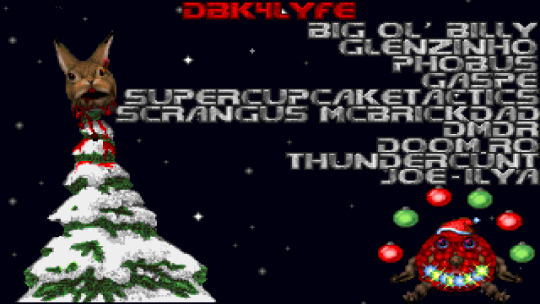
DBP19: A Doomer Boards Christmas Carol
25 Maps by the Doomer Boards Community
2019
https://www.doomworld.com/idgames/themes/xmas/dbp19xmas2

MAP01: Christmas Eve Part I by Big Ol' Billy
The first teaser to this new adventure is a small hub that shows us a cozy house that follows a simple Christmas narrative to set the mood. 4/5

MAP02: Hornaments by Big Ol' Billy
The first actual map with combat, and it is quickly let go. A circular arena with a considerable amount of enemies surrounding us. The dark design and simplistic architecture give it a rather ominous feel. We will also quickly discover one of the new hidden mechanics: shooting the bells. 3/5

MAP03: Christmas Eve Part II by Big Ol' Billy
All maps will have an intermission that leads to the main hub, which also acts as a progress and rest center for reading Christmas letters. A fantastic idea that generates a unique identity. 4/5
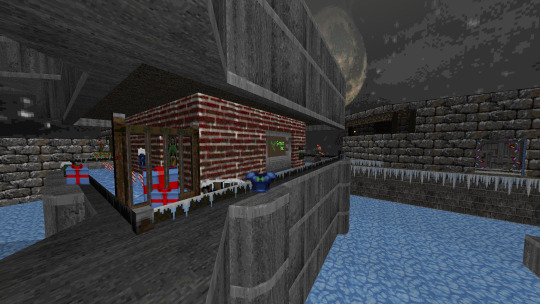
MAP04: Festive Neighbours by Phobus
Following the tradition of MAP02 but this time in a frame. Enemies are far away and in ambush positions, waiting for the perfect moment to attack. With a claustrophobic design and a bit lost at times (the bells are well hidden) is a map that takes relatively a little more than it should. 3/5
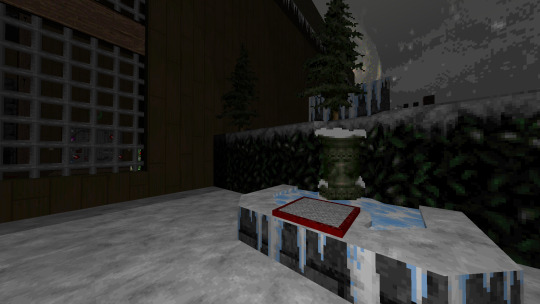
MAP05: Christmas Eve Part III by Big Ol' Billy
Next intermission, this time we realize that our lovely home is starting to be invaded by bad guys. Oh, Sa(n)tan will be mad. 3/5

MAP06: The Pilgrim and the Hermit by Gaspe
A large map with a rather intricate and claustrophobic design that leads to a variety of paths with various small puzzles and bloody combat. The cold is felt in the hooves. 4/5
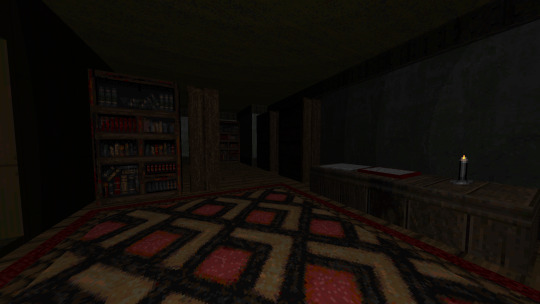
MAP07: Christmas Eve Part IV by Big Ol' Billy
Haha. Good times. 3/5

MAP08: Surprise! by glenzinho
A medium-sized Doom-city style map with a surprising design, a multitude of secrets, a small ''bell hunt'' and a progressive combat that changes and varies constantly. Fun and full of Christmas spirit. And demonic spirit too. 4/5
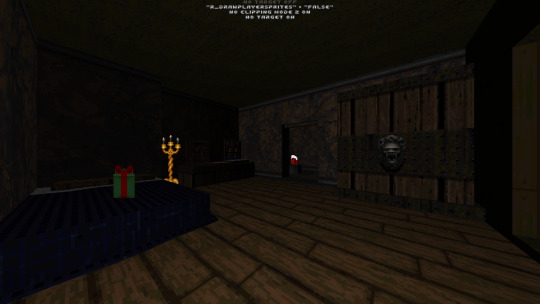
MAP09: Christmas Eve Part V by Big Ol' Billy
An intermission with a... surprise... ending. 3/5

MAP10: Winter Wonderland by Phobus
A surprising wonder, dark, cold and with a unique touch that delivers a variety of visual designs on a large map with fun gameplay that flows seamlessly. 4/5
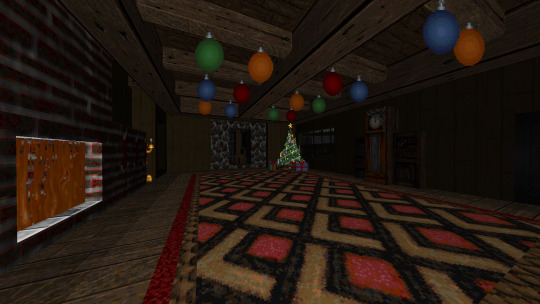
MAP11: Christmas Eve Part VI by Big Ol' Billy
A hot little adventure. 3/5
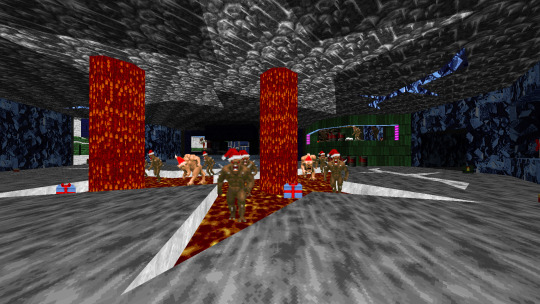
MAP12: The Nut After November by SuperCupcakeTactics and glenzinho
That name is unique. For that alone it deserves an extra point. Anyway, this is a medium-large map with a multitude of interconnected roads and tight combat. Fun and with a good Christmas charisma. Hope you aren’t afraid of spiders. 4/5

MAP13: Christmas Eve Part VII by Big Ol' Billy
Ah yes, hello. 3/5

MAP14: Two Sizes Too Small by Doom_RO
A huge adventure that involves hunting different bells and quite aggressive combats through a detailed map with a pleasant and well designed design. Unfortunately, the bell hunting can be a bit irritating due to the simple nature of switch-hunting in its primordial state, but it's still a great map. 4/5

MAP15: Christmas Eve Part VIII by Big Ol' Billy
Did you know that Xmas in Romania is beautiful? 3/5

MAP16: Christmas Tree Mountain by Scrangus McBrickdad/Jaxxoon R and glenzinho
A large map with a relatively small population for its size. With an intricate design and variety of scenarios, it has a fun formula but its layout is somewhat slippery and the progression is somewhat affected. 3/5

MAP17: Christmas Eve Part IX by Big Ol' Billy
Now we explore more and more of the city in these short intermissions. 3/5

MAP18: Xmasphobia by Thundercunt
A claustrophobic and cramped map with a labyrinthine design vaguely reminiscent of Tricks 'N' Traps meets Fear of Plutonia. Interesting premise with great design. 4/5

MAP19: Christmas Eve Part X by Big Ol' Billy
Probably the hottest intermission, to the point that it could be considered a tiny map. 3/5

MAP20: Krampus Anomaly by dmdr
An excellent map with a great flow and exquisite combat, varied and with constant dynamics between the player and the fun, coupled with a good design and understandable layout. 4/5

MAP21: Christmas Eve Part XI by Big Ol' Billy
An intermission that reveals us beyond the labyrinth. Optional but rewarding exploration. 3/5
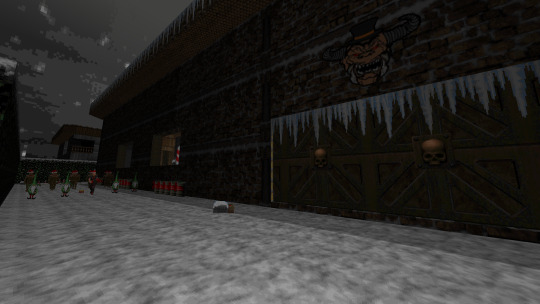
MAP22: Where Cybneezer Hid Christmas by joe-ilya
A small adventure through a kind of infnerla mansion. Secret paths and dense combat make this map a fun mission. 3/5

MAP23: Christmas Eve Part XII by Big Ol' Billy
The last intermission makes us take a walk through the wintry and dark city to get ready for the last adventure... or maybe not. 3/5

MAP24: Realm of Christmas Time by Big Ol' Billy
The "fine" map, in quotes, is a great entertaining arena with a kind of dynamic IoS that makes us face a huge variety of enemies in a small circular arena. Fun and frenetic in an expansive Christmas violence. 4/5

MAP25: Christmas Morning by Big Ol' Billy
The so famous city of the intermissions is finally given its own use in a magnificent slaughter map that will stop us in our tracks. Enormous, large and with an incredible challenge for all players. The ultimate Christmas present goes out with a boom. You're not supposed to win it (it's technically impossible) but it's a fun and crazy way to end this wad. 4/5
Overall:
» DBP19: A Doomer Boards Christmas Carol (2019) By the Doomer Boards Community
We all want to get into the enchanting spirit of the sweet Christmas season as December approaches. Nothing like celebrating the times of peace, love and understanding among all beings as by doing it in the most holy and fantastic way possible: Killing demons. Those infernal sinners are not going to clean themselves and we are here to do it. Thanks to the fantastic criminal minds of the members of the Doomer Boards Community, we have been given a fantastic Christmas installment that has all the necessary requirements to recreate a good Christmas spirit; blood, violence, guns and many, many demons. Ready to celebrate Christmas? Hit it.
A Doomer Boards Christmas Carol is a project created by the famous krew that this time is launched towards the winter celebrations of Christmas, creating a theme focused entirely on the Christmas touch of the game and redesigning textures and skins for almost the entire project, perfectly invoking that Christmas spirit that few can achieve with a game that was practically identified as a form of 3D Satanism (although it was not exactly released at Christmas, it is a Christmas game in my heart) that would launch to the market a re-copied and unique style. That of being gory and disturbing. Well, let's take the core of Doom and now give it a new twist, one that has lots of snow, cookies, warm milk, presents, red socks and some coal for the bad kids. The result? A grandiose 25-map project (half of them small intermissions) that perfectly re-invents the celebratory style into a Christmas mood that successfully recreates the game on, you guessed it, Christmas. Or something like that.
DBP19 is a fascinating project like no other that really manages to reach those standards and deliver white maps full of passion, identity and a lot of fun. Thanks to the new use of textures and the hilarious re-skins, we now have a new paint scheme for the entire game that takes us out of the hellish air and into a cooler and, uh, wholesome kind of hell.
Starting with MAP01 by @Big Ol Billy, the first map actually works as a kind of intermission/hub-styled map that makes us progress the game accompanied by a small Christmas narrative where the different members of the team give us little stories and messages about what awaits us or the story. A little touch that gives it a nice charisma. @Big Ol Billy does practically all the intermissions, as well as a few other independent maps. MAP02 continues the adventure and this time throws us directly into a combat arena that presents us with two important aspects: 1) the visual style and 2) the new mechanic of hunting ''bells'', something like switch-hunting but more simplified. MAP03 is one more intermission made by the same author, and from now on all the maps with odd number are intermissions. MAP04 by @Phobus is a re-interpretation of the first map but with a more painting style and less mercy. Gaspe comes into action with his MAP06 which gives us a great rock fortress in a world of ice full of action and beautiful visuals. MAP08 by @Glenzinho is, as the title says, a violent surprise that shows an excellent Doom-City style. @Phobus returns with MAP10 in an intricate and tight map with dark corners and welcoming demons. MAP12 by @SuperCupcakeTactics and @glenzinho wins the award for most innovative and fun title I've read all year, luckily not all is title but also essence as this is a fascinating map that combines the two styles of mappers under a perfect synergy of emotion and visual sweetness. MAP14 by @Doom_RO is a huge odyssey that makes us look for different bells while we go through different scenarios making our way through rivers of demons, all in an exciting Christmas adventure. Oh yeah. MAP16 by @Scrangus McBrickdad/Jaxxoon R and @glenzinho pits us against a huge map with amazing visuals but a somewhat confusing layout that compensates with a nice touch of detail and variety of scenarios. Thundercunt (hehe) delivers a labyrinthine and different adventure that contains as many goodies as the demons in MAP18. MAP20 by @dmdr is a fascinating ice adventure that takes us on a journey with good flow, fun combat and excellent presentation. @joe-ilya delivers a mysterious and cold mansion in MAP22, full of demons, Masterminds and a few surprises in the basement. Finally, MAP24: Realm of Christmas Time by Big Ol' Billy is an excellent final scene as we face off in a small arena-style map against a variety of enemies and a sort of modified IoS that delivers thrills and excitement. Like the good little kids, we've been. Of course, the final intermission in MAP25 is what we call a total beast that actually works like a credits map but with a twist.
Wow that was a lot of maps! Probably among the biggest (or actually biggest) DBP, quite the gift!
This winter adventure deliberates with solid greece a delivery of 25 maps full of charisma, fun, gifts and everything we need to feel comfortable and accompanied on a lonely Christmas night while the snow crashes against our windows. Not that I can relate to that because where I live it doesn't snow, but at least with this project I have managed to relate the sweet effect of nostalgia with the innocence of yesteryear where we simply wanted to enjoy Doom in its purest form. Well, this is the purest way to enjoy it at Christmas! Or practically any month, after all I'm playing this in the middle of summer. Hehe. Anyway, want some cookies? Come and get them.
18 notes
·
View notes
Text
ok alright alright alright kingdom episode two
kinda disappointed that they only showed half the stages, but that's just an editing thing to draw out the content so you can air for longer, i'm not super surprised about that. i would have liked to evaluate them all at the same time, but at least this gives me time to go more in depth for all of them since they're full stages this time and I wrote 3000 words for last episode when they only had 100 secs. so this format will probably keep me sane for longer, i think.
solid stages all round for them, none had especially glaring flaws on the whole. i'm not gonna do a full ranking for this episode since we haven't seen them all, but i will say that btob’s was my favourite from this set and both ikon’s and tbz’s stages were about equal; they both had things i liked and disliked in equal measure so i'm tentatively giving them the same ranking. full opinions and analysis on each stage below the cut, plus another section of general notes because hey what the fuck did you do to that stage mnet???
and for anyone that’s wondering yes i do have the qualifications. also seriously grab a drink or something because this is LONG.
some general notes
and here i thought this section wouldn't be as big as it was last time because mnet was going to get their shit together about the stage design, but noooooooooooo they had to go and make it worse! thanks mnet i hate it! remember how i said you shot yourself in the foot last time? well ya fuckin kneecapped yourself AND all your idols with this one ya dumb fuckin idiots. alright folks welcome back to stage design 101, my recurring segment where i explain the different types of stage layouts and their effectiveness for kpop idol survival shows, i guess.
ok so last week i covered the basics on theatre in the round and traverse staging, which i’ll link here if there’s anyone new or just wants a refresher. i mentioned that its likely that mnet will switch to an in the round style staging because it offers a lot more freedom for camera movement and also for directional blocking. well, i was wrong. so i'm gonna give you a quick rundown of prosceniums. a proscenium, proscenium arch, or just prosc, is an architectural feature that sits around the front ‘opening’ of the stage that delineates the stage from the audience. if you've ever been in or seen any pictures of old european style theatres it can be quite ornately decorated with scrolling, but it's almost always there in most western theatres. it basically provides your ‘wings,’ which are where you exit off into to get offstage, they provide cover from the audience sitelines. pretty much any theatre where the audience is directly opposing the stage across the 180 degree line is a proscenium stage, even if it doesn't physically have the arch. hell, movie theatres are prosc stages. now, there's a secondary architectural feature/device called a false proscenium, where you set a second, smaller archway inside the first prosc, usually done for a specific effect. think of it like a literal framing device; it's often used to visually signify that ‘this is a play, we are telling a story, please be aware that this is a play thank you.’ but sometimes, it can be a semi-permanent structure that’s set in place to narrow the prosc opening. we had this at my university, there was a false prosc set just inside the actual prosc because the stage had a hilariously big prosc opening for a university that never had casts larger than 24 people. so they set false prosc in to make the stage slightly narrower and to widen the wings, because it doesn't matter what size theatre you're in, you always need more wingspace. makes sense? ok, now here’s a very quick drawing of what i'm pretty sure the kingdom stage looks like:

before you get lost: stage directions are oriented to a person standing on the stage, hence SL and SR being reversed. a quick tip for remembering which way is upstage and which is downstage: if you go too far downstage you fall down (most stages are raised between 2-4’ from the floor, so if you step off the end you will actually fall.) the arrows on here signify the entrances i observed during the performances, which is not necessary in this explanation but i just thought it was interesting to note. still not entirely sure what the surrounding architecture is but it appears that the stage is a raised platform inside a room, and not actually built as part of the building. the ‘house’ is just a technical term for where the audience is, and in this case it's where it looks like most of the film crew and the producers/staff are. there’s pretty clearly a platform upstage centre, and i think there may be some others but i don't care about those right now. what i want to talk about is this dumbass false prosc they set IN THE MIDDLE OF THE STAGE. now i suspect that they did this to solve some problems that they could have had that i don't know about, since i don't know who the stage designer was and what the actual limitations of the space are. but basically they've built two stages and stacked them on top of each other to create one very deep stage, and then separated it off with a false prosc in order to control the size of the space a little better, and possibly to add some visual interest. this stage is functional for its purpose, absolutely, and i think, if mnet actually gave a shit about point of view and camerawork, it could produce some really interesting performances. however, because this stage is so deep, it kind of has the same properties as the traverse stage from before, but just with some big led screens in the middle for reasons. you extra have to pay attention to the directionality because you have all the staff and cameras concentrated in one specific cardinal point, so you have to get creative if you want to crossover between the two sides frequently. again, this is not necessarily bad; restrictions often produce some of the most creative decisions. but! we have not seen a lot of consideration for camera and sightlines and audience pov, hence why i think this setup is dumb: it’s not facilitating the best performances it could.
ok now to the actual performances
btob
this is my favourite of the group because it's very clean lined and utilizes a few simple devices to pretty good effect. i realize these reviews are making me sound like i only like simple performances but i promise this is not at all true i'm just very critical and very picky. let’s start with the costumes, because why not.
costumes
i like these very much, i love modernized traditional clothing in all forms, and these are very well tailored and well coordinated. they do the bulk of the work establishing the theme for the performance, along with the costumes on the backup dancers. personally i would have liked them to be a bit more colourful, à la the teal detailing that was on minhyuk’s final look. i'm getting a bit tired of the whole trend of having groups only wear all dark or all white, or maybe sometimes red if they're feeling spicy. obviously uniform colour is the easiest way to tie a group together visually, but on a show like this i think the groups would actually benefit more from looking distinct from each other internally rather than establishing the group as whole.
i liked that minhyuk had a costume change but i didn't really care for how it was how it was broken down. this is a very personal quibble because i literally have spent years prepping quickchanges but the method it broke down wasn’t the most visually compatible with the garment and felt kinda clunky. please ignore this anecdote it's just me being picky.
set
i loved the forest! a very excellent way to divide the stage area and obscure the weird stage lines/architecture that mnet has made. plus the snow, flowers, and fog? makes a really sharp and immediately indicative atmosphere, a very good use of visual shorthand to establish place.
i didnt love the screens, they reminded me a bit too much of rolling whiteboards from grade school, but they are thematically relevant. also, i feel like we didnt actually get to see about half the choreo for them? fuckin mnet and idiocy again. fun use of rear projection with the dancers’ shadows, and also good use of them to direct traffic, if you will.
personally i think that the sheet gimmick from tbz’s performance would have been a better fit here instead of the screens, especially since the fabric motif was already established at the very beginning of the performance. plus you can do some really fun shadow work with a stretch fabric screen.
personally i think there could have been a little bit more integration between the forest area and the screen area, or they could have done the whole thing in the forest space, but that would require a bit more consideration of camera and choreo maneuverability
sound
really liked this arrangement, obviously the song is iconic but they added a more traditional instrument sound. has good structure for the loose narrative that they had and they were well to label this as ‘theatre’ version because this did follow very closely to a traditional musical theatre sound and style
lighting
no complaints. the overall theme for this episode is apparently blue and red? again with them i like their dedication to a limited colour palette and i especially like the blossoms at the climax
staging
there was pretty clear camera choreo and a minimum of nausea inducing moves. i think some of the effectiveness of the staging got chopped by the editing but that’s not really btob’s fault.
i was just saying i wanted them to give minhyuk some time to shine, i was not expecting to get it so soon! this is a very smart choreo that proves you can be interesting without doing a lot of tricking. minhyuk obviously did a lot of practice and work with that sword, his movements are very fluid and he knows how to handle it. and it looks like its either a blunted proper blade or a correctly weighted replica. a lot of the times when sword choreo looks fake it's because the person either hasn't had enough practice or the weapon is not weighted/weighted incorrectly. only complaints are that you would never hold your fingers/palm that close and un-anchored over the edge of the blade, which is just a safety thing. also you would never scrape your blade on the ground like that, nor toss the thing like dead fish but that's a respect thing with a live blade and this is clearly done for dramatic effect so i’ll forgive it. please ignore this anecdote also it’s just my third dan getting uppity.
ikon
costume/set
smart thematically to go with the sort of miscellaneous 30s-40s (western) aesthetic because it's the fastest way to make it look like you built a theme with mnet’s weird pseudo art deco nonsense they've inexplicably got going on in the set dec. however, they should have stuck the theme all the way through, it would have been more visually cohesive and more interesting. we expect more hiphop/electronic sounding songs to come with these kinds of 4th gen costumes, it would have been anachronistic in a fun way to have them do that second half in 40s style suits. here’s a performance from sdc3 that uses that kind of anachronistic play (this was a combo stage with two ballroom dancers and it has a 20s aesthetic but close enough.) also here’s another routine from sdc3 that does a similar effect on a much more abstract scale, and also it’s a fucking incredible performance and it got slept on by the captains. also yes i know these are incredibly experienced career dancers but they way they construct narrative within their routines and their stage presence is SO GOOD.
do not speak to me about the backup dancers costumes, holy shit i hate them. i hate them so much. how do you manage to hit too shapeless AND too fitted in the same fell swoop? i'm so mad at these. i'm neutral on bodycon dresses on the best of days but these were absolutely the wrong choice for this stage. generally kpop has abysmal costuming for female backup dancers on the whole but this is just like.....especially lazy. the point of the costume are to help give an indication of where and when you set your performance. they started off with a vaguely 40s theme and then jumped abruptly modern. why? also skirts like that are the literal worst choice for dancing in, hello?? the men’s looks are just sloppy, when you have a garment that big you want it to serve a purpose within the choreo, whereas with this it's just hiding the dancers’ movements.
as for ikon themselves, see everything ive said about black on black on black styling in the previous two reviews.
the actual set is minimal and that's tragic. i mentioned mnet’s weird art deco theme and it was smart of them to try and play off that with a lack of stuff. definitely a mismatch of stuff pulled from yg’s prop storage, but they made it work as well as they could. no other meaningful comments i’m just kinda sad about it.
sound
the arrangement is fine, no complaints from me. they keyed up the old hollywood style musical theatre sound in the beginning which i really liked. i didn't mind the song/tone switch, i think they pulled it off.
staging
same as btob they learned more towards a theatrical style, which is smart for this particular format of show. i think this was the smartest staging of these three, and also i think the only ones to not get the crew in shot.
despite seemingly leaning into a more old hollywood style the narrative was a bit too loose for my taste. i'm not sure what i would have done to make it clearer at this moment since they had so little to work with, but i did get by on my previous knowledge of the songs. that shouldn’t be the only indication of narrative though! all elements need to support it!!
also like btob they had a pretty intentional point of direction and there weren't a crazy amount of spins. they also used the camera cuts the most effectively that i've seen so far. the first half is actually all in one take!!! incredible!!! thank you!!!! this is how you do it!!
the lighter flick gimmick was well pulled off and a good example of how to use a couple of simple tricks to good effect.
ikon as a whole has really great stage chemistry with each other, and they're extremely cohesive performers. this is a really strong physical performance from them, the dance was very solid and clean. good use of levels without verging into acrobatics. this might be the best group choreo i've seen so far, but we’re not very far so that's not a very high bar to clear.
it's a shame they had the budget of 1 banana.
tbz
i liked this stage better than their intro stage, but i still think they have a long way to go and they're still over ambitious. personally i find stages based on specific pop culture properties to be kind of twee and ineffectual, because it requires a specific knowledge of that pop culture property to work. sometimes the specificity can help with a narrative but you're at risk of alienating a larger portion of your audience out of sheer non-knowledge than anything else.
costumes
again, interesting garments physically, but not much clarity of relation to the theme other than the colour. also the backup dancers???? another case of backup dancers being from an entirely different stage, what is up with those coats/dresses? looked more like they belonged in either sweeney todd or a vampire movie.
hands in front of the camera again, but these were used much more effectively. i'm not the biggest fan of mixing metals and i’m partial to silver on the whole so i didn't love the jewelry, but at least it was vague and stereotypical enough to denote ‘fire magic’ even if it does rely on a derivative middle eastern shorthand.
set
the stage set itself is fine, although definitely feels a bit haphazard to me. doric columns and frozen rocks and whatever that cover for the pyrotechnics was at the front, combined with the candles and the chaise lounge? like ikon, it felt a bit like they were pulling out of the props/set storage. not that all these things do not work together, it's just that you need a thread to tie them together, and this didn't have that for me.
sound
it's a crime they have a song called ‘no air’ and its not a jordin sparks cover. just saying.
i didnt really like this arrangement, again like their intro stage it didn't have a strong structure that suited the narrative, because they were pretty clearly trying a narrative on this one. also were most of the adlibs playback? they were singing live but there were so few shots of anyone specific singing.
lighting
probably the weakest of the three. the projection design was a bit too tacky for me, and although i appreciated the small amount of variety in colour, it felt way too concert-lighting for me.
staging
the editing on this stage is wack and did no one any good. the hands leading/pov was a really smart device and they should have stuck out the one takes like ikon did, it would have made the whole stage feel a bit more cohesive. a lot better directional camerawork from them this time around, well done. again with the hands in front of the camera gimmick which i actually preferred this time, since they were a part of the narrative. the stretch/silhouette fabric i think they pulled off quite well, even if it didn't really fit thematically with the piece. i actually worked on a show a very long time ago that used this exact same effect with dancers and also rear shadow projection, and it requires a lot of rehearsal and trust to pull off well, so props to them. i think it was the wrong choice because there isn't an established motif for the fabric, so it kind of appears out of nowhere for one specific visual moment and then disappears, and i think that time could have been better served for something else narratively relevant.
again, these 4th gen groups are overly focussed on gimmicks as a way to make up for the lack of experience. personally i think this will be detrimental in the long run, and a reliance on gimmicks means that you don't trust your performers. tbz have the manpower to be doing some pretty cool collective dance work and i dont think its being trained or utilized correctly. they are suffering from a lack of cohesive stage presence right now and that can be fixed with training and time.
this might be because the group sizes are so different between these three but this choreo is very directionless. mnet is also providing to be absolute garbage at editing and i feel like i can't see the choreo at all.
this is a thing i've noticed with kpop camerawork in general, there’s very little regard for actually viewing the choreo as a singular work. and for some reason the camera always needs to be moving???? people do actually want to see what’s happening on the stage. the choreographer can only see from one spot, so from that spot is how they are intending it to look. you wouldn't need to upload full cams of every music stage if you just filmed the choreo properly in the first place. if you watch the two sdc3 clips i linked you can see a clear difference in maintaining the integrity of the choreo, even though both shows use several cameras and a lot of cuts. obviously for kpop you want the money shots of idols’ faces but i definitely think there’s a healthier middle ground than what we have now.
ill wait for full subs but i want to know where in the fuck in sk you can rent a tank thas clearly been custom made for underwater photography, because that’s extremely cool even if it was absolutely unnecessary to the actual stage itself. i can think of several ways off the top of my head that would have achieved that same freezing effect without any of that wasted time and effort.
mnet decided to drop full cams while i was writing this and despite watching those my opinions are the same.
in conclusion, some more general thoughts:
i think ikon and btob got it right by leaning more into the theatrical than the cinematic, if that makes sense. i might be talking up my own ass here but these are theatre performances, and they should be treated as such. trying to do things that you can do on film isn't going to do you any favours in the long run, and it makes it harder to make a cohesive performance. i’m harping a lot about narrative but it is so important to performance. although it is not technically necessary, when doing big theatrical performance stages like this it does help with clarity of intent and general success. humans have brains structured around storytelling, it is literally the way our history has been passed down for tens of thousands of years. the atlantic published an article recently on narrative and memory, and it's a really excellent read for maybe after you've taken a break from this behemoth, oh dear god.
tldr: the stages were good but disappointing in their own ways. mnet continues to sabotage via weird stage design decisions and bad editing. see you next week! (or in my ask box if you have questions)
#kingdom review#kpop analysis#kingdom#oh dear lord this is almost 4k#to anybody that actually reads this thank you and im sorry#text
16 notes
·
View notes
Text
A Life Thoroughly Lived: Review of The Invisible Life of Addie LaRue (Spoilers Ahead)

(Cover, Titan Books UK).
I have this distinct memory from when I was twelve: sitting in a McDonald’s after a morning in my homeschool e-learning program, eating french fries and reading the school’s library copy of Cornelia Funke’s Inkheart. This book was groundbreaking for me for a multitude of reasons, but one of its quotes became firmly stuck in my mind. Meggie’s father and secondary protagonist, Mo, reflects on books through this line: “Some books should be tasted, some devoured, but only few should be chewed and digested thoroughly.”
This line becomes entangled with my 12-year-old psyche, and I never quite let it go. The idea fascinated me: not only the novel idea of comparing books to nourishment, but the point that some books are not made to be read quickly and once. Some books are chewed and digested thoroughly.
I read that quote in 2005, and even then, at the cusp of the digital tipping point and prior to the smartphone, you could feel the inglorious pressure to consume anything you read if you read for pleasure at all. Conversations with my peers about books were rare, and what bonds I did have about creative writing were made over the internet via fanfiction.net: that wouldn’t change again until Twilight hit it big a few years later. To enjoy a book was to binge it and consume its content only, and so this quote wasn’t entirely understandable until I entered college- and became a writer myself, when I discovered the merit of craft.
This feels like a long way of saying I enjoyed one book, but I cannot stress the rarity of true craft in fantasy fiction. Genre fiction in general has a history of shaving off literary merit and form in favor of YA-style writing and clipped, action-oriented narration. It is what’s popular and there’s nothing wrong with this style of writing, but it is a style of writing made to be devoured. I often hoped to encounter that one modern fantasy novel, made to by chewed and digested slowly.
This brings me to The Invisible Life of Addie LaRue.
If you exist on the internet’s writing/reading spaces, you probably know V.E. Schwab, whose prolific career now spans a decade. Her most popular works, including her Villains and Shades of Magic series, tower over the 2010s as important entries to the SFF world, alongside a young generation of female authors— Naomi Novik, Leigh Bardugo, Seanan McGuire, N.K Jemisen, to name a few, who have helped change the definitions of SFF and what it means for women to participate in male-dominated writing spaces.
This is perhaps what makes Addie LaRue so visibly important, because its role as a serious, literary work as well as a groundbreaking fantasy novel, fully cements Schwab’s role as an important author of the 2010s.
The story of Addie LaRue is simple enough: in a small French village in 1714, Adaline LaRue finds herself at odds with her world: her desire to travel, her attraction to the old gods, and her want to experience life are combated by a world that expects her to marry and have children, living and dying in the same plot of land. With an arranged marriage at her heels, Adaline only desires freedom, adventure, and more time in a dwindling, small life. Against the advice of her village’s wise woman, Estele, Adaline prays to any god that will offer her a means of escaping this cruel fate.
Her desperation attracts the wrong god, who agrees to take her soul in exchange for a life without limits. This grants Adaline immortality, neither aging nor dying. But at the cost of her presence: anyone who encounters Adaline LaRue forgets her, the moment she is out of view. Any mark that Adaline leaves is erased, any suggestion of her past life is smeared from existence. The god— or Devil, erases her being in hopes of making her give up her soul. Adaline spends the next 300 years in limbo, forgotten and invisible to the world, until a New York bookseller catches her stealing from his shop and remembers her face.
The story itself oscillates being Addie’s present: New York in 2014, and her past, reaching back to pertinent flashbacks about her life in rural France, out onto the wider world over 300 years of life. Rather than clashing, these two timelines compliment each other, allowing Addie’s past to compliment the unending road that is Addie’s future. And unlike some immortal characters, the weight of the 300 years can be felt in Addie’s character while she wanders the labyrinth of a modern New York.
While heavily populated with 300 years-worth of characters, the novel uses most of its time on Addie, her infernal deal broker, a supernatural being she calls Luc, and Henry Strauss, a bookseller in New York with his own set of secrets and heartbreak. One might argue that the relationships between Henry, Luc, and Addie constitute a love triangle label, but their dynamics are far more complicated given the “magic” and sexual identities involved.
One refreshing element about Addie LaRue is that both main characters, Addie and Henry, are explicitly bisexual in a way that feels humanistic and real. Addie’s view on relationships is complex, simply because she cannot maintain a relationship beyond first encounters. Her liaisons, modern and historical, become a conversation with her personal relationship with eternity. Her relationship with Luc is also complicated, evolving from lustful daydream about the “perfect stranger,” to willful tormenter across her deathless existence, and finally, a troubled companion in a lifetime where only Luc understands Addie’s painful existence.
Henry Strauss comes to Addie’s life as the first human to remember her in over 300 years: their romance is sweet, passionate, but forever marred by the fact that both parties are somehow cursed. Their existence together is fragile, and as presented by the novel, a tenuous moment in a long life. Henry changes Addie’s trajectory, simply because his existence feels so short in the scope of her eternity.
With all that said, The Invisible Life of Addie LaRueisn’t so much a love story about Henry Strauss or Luc, as it is about Addie LaRue understanding herself. It is a love letter to a young woman, forever trapped in her early 20s by a single, impulsive choice. 500 pages (at least, on my edition) and most of book is spent on Addie’s life: the evolution of her moral justifications for theft, prostitution, and overall survival. Her strained views on humanity as her lovers and acquaintances age and die around her.
A particularly interesting, recurring flashback is Addie’s annual trip to her childhood home, Villon-Sur-Sarthe, in which she returns to witness the passage of time in the village. Like Dorian Gray and his portrait, Addie’s home withers and folds into the extended woods before it is bulldozed into modern land, all while she remains the same. Her family is buried, her friends are gone. Addie attempts to leave signs of her ghostly existence in the village by planting a tree, only to discover it struck down in a storm during her final visit. When she blames Luc for the destruction, yet again, her reminds her: “I know I can be cruel, but nature can be crueler.”
Unlike Dorian Gray, this is no polite justice to strike down Addie LaRue, which complicates the morals of the novel. Addie LaRue’s narrator is not interested in moral judgements or rounded poeticism as we observe the long life of this immortal woman, instead exploring Addie’s personal, sexual, and internal changes as a matter of an existence beyond the shackles of normal humanity. The narrative choice of third person, present tense lends itself considerably to this fact, allowing the reader to experience Addie’s life in real time and alongside her present and past selves. One very interesting narrative choice, during flashbacks, is the occasional intrusion of the narrator by way of the word “will.” Moments of tragedy and difficulty will flash through past-Addie’s life, only for the narrator to gesture elsewhere and let us know what impact this choice “will” have on Addie’s life later.
It is a very clever slight of hand, since it keeps the audience moving between past and present without distracting away from the story overall. Rather than tipping its hand too heavily, the narrator offers breadcrumbs to the audience in an overfolding adventure, encouraging us to follow Addie from rural France, out to Paris, Venice, Berlin, over into the Americas, from Chicago to New Orleans. These locations and details would feel massive and glossed over, if not for the narrator’s active participation as a storyteller.
This narration also helps the reader comprehend the scope of Addie’s growth, offering a more mythical perspective on a woman who is human— but not quite. Addie is cursed, yes, but finds strength and power in weaponizing the curse against Luc. She plants herself in the minds of artists, musicians, and writers who find ways to pepper her presence along history, as delicate as the seven freckles that constantly appear in her portrayals. Addie LaRue is forgotten but reaches across history in a deep desire to be remembered and ageless.
The novel’s end, without spoilers, arguably accomplishes this goal. I’m not sure yet if the ending is supposed to be happy or not, which is perhaps why I enjoyed it so much. The book required more thought than the average fantasy piece: it was written with the idea that it should be read slowly and digested thoroughly. Every word, detail, and choice are made with reason, like a cog that helps move a clock’s gears. Nothing is wasted in this novel, both craftsmanship and good storytelling coming together for a truly enrapturing experience.
I will try to revisit The Invisible Life of Addie LaRue in the near future, to draw more magic from its well. I hope you’ll consider exploring its pages too, and I have high hopes for the future career of V.E. Schwab.
9 notes
·
View notes
Text
The weird politics of the Blip
The more the MCU fleshes out the events after Avengers: Endgame, but especially in Falcon and the Winter Soldier, the less sense the geopolitics of the MCU makes to me. In this essay I will be sharing my perspectives on politics in the MCU. If you’re not interested in that sort of thing, don’t feel obligated to engage. Also, by the very nature of this essay it will involve spoilers for the MCU and discussions of topics like state violence and terrorism, so consider this a trigger warning.
It’s an understatement to say that the world would change radically if half the population would randomly disintegrate, and I understand that speculating on the consequences of those people coming back after five years is no simple task. There might even be story considerations I am unaware of.
But the idea that the world’s governments would immediately start forcibly removing people from the homes they lived in for five years, to accommodate people who were declared dead five years ago sounds really strange to me. Let’s explore this.
If you were the survivor of a disaster that cut the world’s population in half, what would this look like to you? You’ve presumably went through a lot of hardship and trauma in the years following. You’ve sold some of the things belonging to your deceased loved ones, or bought stuff from other people in a similar situation. You may have relocated, started a new family. Grieved.
And suddenly those people you literally saw turn to dust in front of you just appear again, like nothing happened? Literally in the same befuddled state in which they died.
And I have to stress: they died. there is no way to suggest that a person can be atomized and still be alive.
So why would you even trust that this was the same person? In a very real sense, it’s an identical copy of your deceased loved one. Similar to teleportation, this should cause us to wonder if they were truly resurrected, or merely cloned. What kinds of rights do they have, being legally deceased? Would we even know if these were impostors, if the situation changed them somehow?
I’m not saying there’s no answer to these questions, just that people should disagree on this. People would have high-minded philosophical, scientific and religious debates. Conspiracy theories and fistfights. This is by far the most world-changing event ever recorded. It should have massive ethical, political and spiritual implications.
And what I think we should think about is that these people who returned have nothing. They have no memory or lived experience to prepare them for this different world, all of their material possessions belong to someone else now, and by definition, all political, economic and military power is held by those who stayed, who now have a material conflict of interest, because if they acknowledge that you are the same person and deserving of the things you had 5 years ago, they have to give it back. Even without the administrative nightmare this would represent, the returned have nothing. Even their work experience is practically meaningless, especially in high-paying jobs.
What would happen if Steve Jobs somehow magically returned, having no idea what Apple had been doing in the last couple of years, and demanded to be put back in charge of Apple? It’s not exactly an easy ‘yes’, is it? The world’s power balance would be forever shifted.
I’m not saying everybody would be unsympathetic to the plight of the people who unblipped. But I am saying there would be a massive movement or series of movements opposed to giving them back their stuff. And I’m saying that movement would not only be popular but also backed by every powerful business interest and government.
Because realistically, the unblipped would be the refugees. They are the ones who would have lost everything, fighting an uphill legal battle to even be recognized as alive and as the same person they were 5 years ago. They would be the ones in camps, waiting for supplies.
Ironically, they would be the ones most hurt by the status quo returning to normal, as there is no way to keep massive famines and shortages from happening in this situation without international coordination.
So why did the MCU decide on the opposite idea? There are two arguments I can think of: one narrative, and one political. On a narrative level, speculating on a changed world is complicated and risky. If Marvel wants to make stories relevant to us in our world, they have to more or less get back to a status quo we would recognize before it would complicate their properties going forward.
The second reason, I think, is that to truly explore a world like this is radical and potentially a liability for Disney, both in terms of their audience and their relationship with the US military.
Of course any real discussion on policy in this situation requires the heroes to at least pay lip service to a political opinion, which could cost them a lot of fans. We are talking about the legitimacy of borders, of private ownership. Any examination of the edge cases will cause people to have Strong Opinions of their own. In a crisis like this, can people squat in empty houses? Do these people have human rights and refugee status, and how should those be protected in the real world? Can any state justly displace people and if not, are these people allowed to disobey the government or even fight them?
Since the US military subsidizes Marvel’s use of military hardware, it has script approval. So that can also explain why they can’t make the US government the bad guy or present a truly different world where the US military is rightfully no longer in control.
Who can legitimately deprive people of things they need to survive in a crisis like this? What’s more important: the right to own a house and keep it empty if we so choose, or the right to live in a house?
If we get too deeply into it, Karly’s position (in theory) seems very compelling, like Erik Killmonger’s before her. And so, they have to make her (like him) a hypocrite who goes too far, so it doesn’t seem like the MCU is advocating violence against the state.
Karly’s ideology is muddled by the writers because the violence she performs has no chance of actually achieving her goals of global solidarity. It feels tacked on to make her less sympathetic. Realistically, someone like Karli would be holding political rallies, sit-ins. Writing op-eds, staging marches and organizing her community into self-sufficiency. Possibly getting into fights with the cops during evictions or protests. If you read Falcon and the Winter Soldier as a kind of allegory for American politics, then Walker represents Trump, Sam represents Obama, and Karly represents... whatever conservatives think socialism/BLM is?
So it feels like FatWS is trying to thread the needle: Nationalism is bad, but so is statelessness. A state should have integrity, and benevolence. And it can have those things, if represented by the right people. Then, the violence is just and measured. It’s barely even violence at all.
I’m kidding of course, the kinds of solutions the MCU offers are basically ‘Co-Intelpro, PMC’s and neighbourhood watches... but run by morally perfect people’. It’s the way a propagandist would represent clandestine domestic espoinage or police brutality: Sam and Bucky would never kill anybody defenseless, and they would never interfere with legitimate polical movements. Because the writers create a perfect world where it’s always clear what everybody’s intention is before the fighting starts, and non-lethal violence is a reliable default option, no more morally problematic than some rough-housing by rambunctious kids.
I know I can trust Sam and Bucky because the writers would never give them realistic implicit biases in a way that would endanger their moral character. They are perfect because they are not real.
The robots, aliens and wizards are not the only unrealistic thing about the MCU. we have to be aware of how artificial the politics are, even if we want to suspend our disbelief. Or else we end up trusting politicians when they embrace a fundamentally immoral status quo, and let thousands die to maintain it (I know, a WILD hypothetical that will surely never come true, but worth keeping an eye out for.)
The politics that a blip would realistically set in motion are so different from our own, that it would call into question the legitimacy of private ownership and the state. In order to avoid upsetting its fans and its financiers, the MCU has to return to a status quo where those political realities can be taken for granted.
10 notes
·
View notes
Text
Article: Marginalization Tourism and the Smoldering Youth
“I am not what I think I am, and I am not what you think I am. I am what I think you think I am.”
Charles Horton Cooley
As recently reported by NBC news, a study published in the journal Pediatrics found that 9.2% of survey respondents from 13 high schools in the Pittsburgh, Pennsylvania metro expressed a incongruity between the sex of their birth and their experienced gender identity. In contrast to this study the similar, but broader scoped, 2017 Youth Risk Behavior Survey found that only 1.8% of surveyed 14-18 year olds self-identified as transgender, up additionally from a 2011 two-state survey (Gates) that estimated only 0.3% of the total U.S. adult population to identify as transgender.
In response to these data I’ve found myself considering the causes of this explosive growth in gender dysphoria, and frankly, have found it puzzling. Yes, it’s absolutely plausible that subtle cultural changes and broader acceptance of gender fluidity in Western culture has played a significant role, but over a ten year span (‘11-'21), a growth rate of more than 3000% clearly indicates that the catalyst of the change is more substantial than a shift in “repressive” mores.
Adding even more intrigue is the fact that though the Pittsburgh study found that more Black, Hispanic, multiracial, and other respondents identified as gender-diverse (which one might expect from the demographic makeup of an inner city school district), an observing pediatrician and adolescent medicine fellow at Children’s Hospital of Pittsburgh, Dr. Kacie Kidd, anecdotally reported that the vast majority of minors who visit her university’s gender and sexual development clinic are “white, upper-middle-class, *masc-identified youth.” Dr. Kidd implies that this racial disparity is most likely due to health care discrimination in the United States, but I would contest that this is only a part, and more than likely a small part, of the greater picture. Rather, I suggest that the rapid growth of gender dysphoria among Caucasian minors is neither due to a shift in familial and cultural mores or an example of latent racial discrimination in healthcare availability, but instead due, in part, to the rise of a phenomena that I’ve begun calling Marginalization Tourism.
Marginalization Tourism, as I’ve observed it, can be defined as the conscious or unconscious adoption of a moniker deemed “marginalized” by an individual hoping to gain a protected or unique social status—in this case, gender identity, but other examples of Marginalization Tourism (Rachel Dolezal or Oli London) also exist. Similar in ways to a form of social Munchausen syndrome, Marginalization Tourism takes virtue signaling and “allyship” to their logical conclusion by attempting not only to empathize with a population deemed “marginalized,” but rather to falsely inflate the intersectional status of the adopting individual by grafting perceived trauma or subjective labels of marginalization onto their own lives. As was aptly suggested by a friend and colleague, Reed Uberman, the real life implications of Marginalization Tourism can look similar to the “cutting” phenomenon of the early ‘00′s, yet the self-harm of that era was born out of the hopelessness flowing from the Nihilist Postmodern Condition. In contrast, the Marginalization Tourism of today, encouraging children to self label as post-biology, is born out of the Metamodern Condition. A condition that views the conventions (or in the case of this argument, gender norms) of the past merely as archetypes or myths on which to build the magically oppression-free trans-structural utopia of the future.
To help with qualifying Marginalization Tourism theory and specifically its impact on “white, upper-middle-class” youths, a brief consideration of the roles played by technology, society, and politics in the formation of this phenomenon is in order. Especially because these factors have become increasingly influential among those who are both highly vulnerable to peer pressure and prone to the adoption of extreme thinking (and thus extreme behavior).
Technology’s Role in Marginalization Tourism
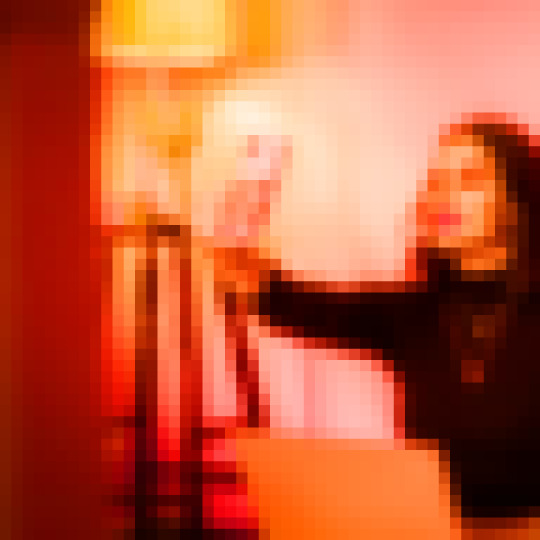
Though in the past technology has had an important impact on mores of youth culture (see MTV Generation), its former one-way nature limited technology’s actual narrative influence over the lives of individuals, and was mostly kept in check by the random and disparate influence of local mores. Yes, moments of technology-catalyzed cultural cohesion would rise in communities, often culminating in the development of a local fashion, slang, or music and art scene, but would rarely extend beyond the borders of that region. Rather competing regional preferences would naturally limit the exponential spread of viral forms of subcultural behavior.
But today children are raised within a global technological ecosystem that particularly values the novel, the unique, or the extreme—where in contrast, being young, White, middle-class, and American is considered antithetical to those “virtues.” Thus to meet this In-group Bias-fueled fetish for the novel, if a young, white, middle-class, American netizen hopes to both protect and grow their online “personal brand”, adopting niche labels, celebrated by the online progressive monoculture as novel, unique, or extreme is not only important, but at some point, critical. For evidence of this escalation look no further than the explosive growth of OnlyFans, the direct to consumer pornography service for increasingly extreme behavior and niche lifestyle content, with former PG-13 Instagram “influencers”, or the sexual or gender identification evolution of social media spotlight-dependent celebrities like Demi Lovato or Miley Cyrus.
Being simply a tool, it’s important to remember that technology is ultimately agnostic to the extreme label adoption behind Marginalization Tourism. But likewise it would be absurd of us to ignore the impact that Reddit and TikTok-hosted spheres of influence, steeped in the aforementioned In-group Bias, emboldened by all-accepting Progressive Metamodern ideologies, and fueled by a lust for the novel, have had over lifestyle preferences of today’s impressionable youths.
Society’s Role in Marginalization Tourism

Sociologically, when thinking about development of Marginalization Tourism it’s crucial to consider the importance of symbolic representation during identity development. As coined by the imminent sociologist George Herbert Mead, we all employ “significant symbols” to communicate personal meaning outwardly and look for similar symbols as recognition of in-group acceptance. This use of significant symbols is particularly important during adolescence, when gaining in-group status is most important for emotional well being. Further, research (Adams et al, 2003) suggests that outwardly symbolic self-labeling by youths can be a predictor of actual behavioral adoption, most likely reinforced by the desire for in-group status.
Yet for those whose in-group status has been politically nullified (more on that below), the hunt for acceptance has continued to grow more desperate. No longer governed by the traditional group segmentation symbols: fashion, music, athletics, economic status, etc. those who have fallen afoul of our current political stigma machine have begun to reach out further—to gain in-group status not through these traditional symbols of in-group status, but via the increased adoption of labels of marginalization and thus intersectionality. Gone are the days of authentic subculture development and acceptance, which would have at other times been the refuge of these social exiles. Rather, they’ve been crushed under the weight of Metamodern sarcasm, to be replaced with vapid variations on the same milquetoast metanarrative—one that mindlessly drones on about the virtues and infallibility of dogmatic Progressive Collectivism.
It’s for these reasons why I observe Marginalization Tourism most uniquely among Dr. Kidd’s “white, upper-middle-class, *masc-identified youth.” This is a demographic derided as having no symbolic value in our current culture and because so, is incapable of building in-group status among peers without co-opting the social currency du jour, a history of marginalization.
Politics’ Role in Marginalization Tourism
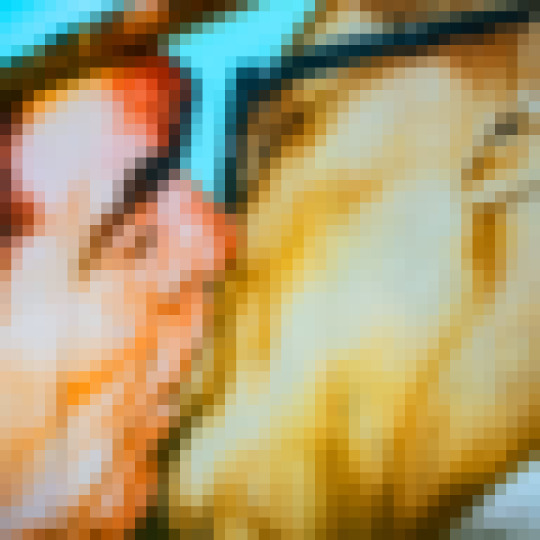
Lastly, we will address the role that politics has played in setting the stage for the growth of Marginalization Tourism. Rather requiring a nuanced argument on the political catalyst of Marginalization Tourism, all that’s really needed is to simply open our eyes in any newsstand or bookstore, university lecture hall, or on any media, entertainment, or Big Tech platform and we will be spoon-fed a veritable deluge of information with the aim of first deconstructing, and then demonizing the societal contributions Western civilization. Whether it’s via culturally-promoted avenues, like The New York Times’ The 1619 Project, passed through longtime cult classics such as Zinn’s “People’s History,” or subtly woven into the agitpropatainment of The Handmaiden’s Tale, the consistent political narrative states that being Caucasian, and by extension, a product of Western civilization, is intrinsically and irreparably bad. Further, when this political posture is adopted by virtue signaling parents (where youths first seek value, stability, and familial in-group status), their progeny, who by no fault of their own physically and symbolically represent the so-called evils of Western culture with the level of melanin in their skin, are of course going to identify with the concepts of self-hatred and intrapersonal alienation so often reported by people with gender dysphoria.
And of course they will. Who wouldn’t feel a profound sense of remorse and humiliation when, as a child and adolescent, you were placed under the deconstructed burden of Western civilization’s so-oft illustrated legacy of failure and oppression? Even moreso with young, White males, who also have to atone for the repugnant actions of some of their past male counterparts.
We, much less our children, are not strong enough to contend with that burden, and the more that it is promoted as a labeling narrative, that symbolically defines their personhood, the more that our children will want to flee from any aspect of their “idiotically banal” and “intrinsically oppressive” identity.
I will be discussing additional aspects and possible counteractions for stemming the tide of Marginalization Tourism in the future, but in the meantime suggest that our first step toward combating this phenomenon of misidentity is to reject the idea that our intrinsic value is subject to the whims and opinions of consensus. Rather, I implore my readers to turn from the fickle advice offered by their limited perspectives, existential crises, and internal micronarratives in favor of the eternal wisdom of God and his son Jesus Christ who said in the Gospel of Matthew, Chapter 10:26-31:
“So have no fear of them, for nothing is covered that will not be revealed, or hidden that will not be known. What I tell you in the dark, say in the light, and what you hear whispered, proclaim on the housetops. And do not fear those who kill the body but cannot kill the soul. Rather fear him who can destroy both soul and body in hell. Are not two sparrows sold for a penny? And not one of them will fall to the ground apart from your Father. But even the hairs of your head are all numbered. Fear not, therefore; you are of more value than many sparrows.”
4 notes
·
View notes